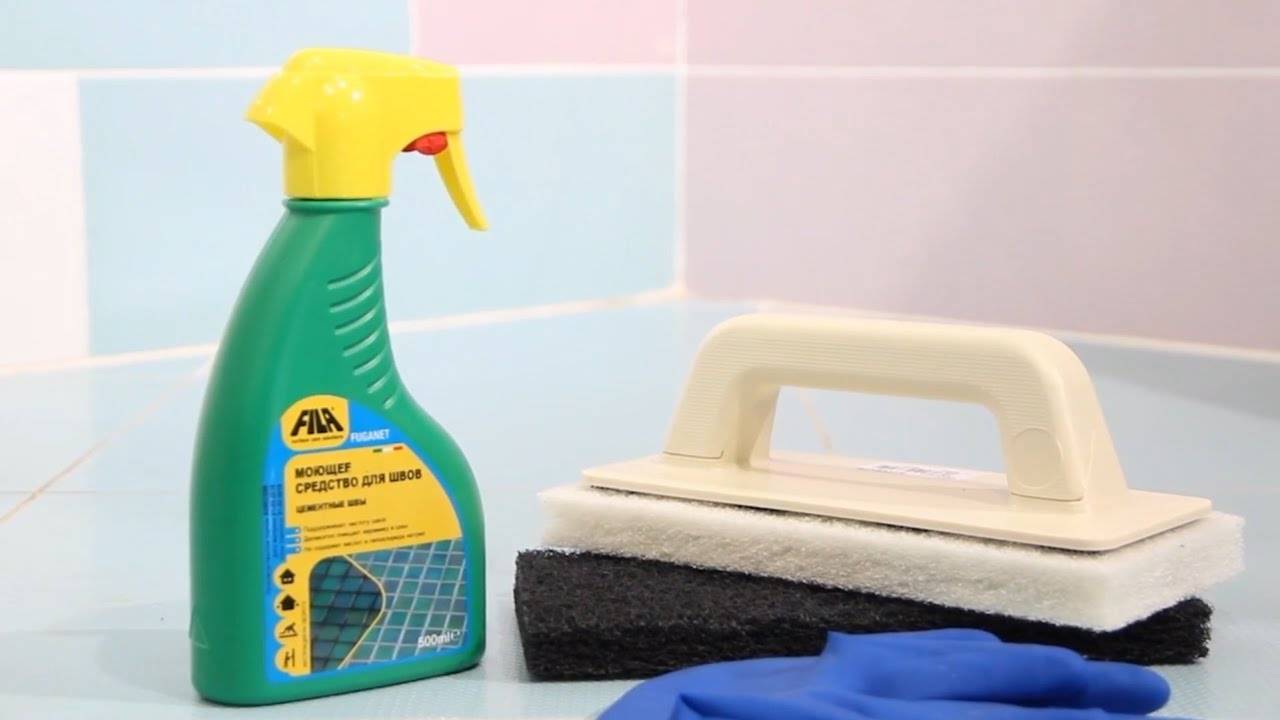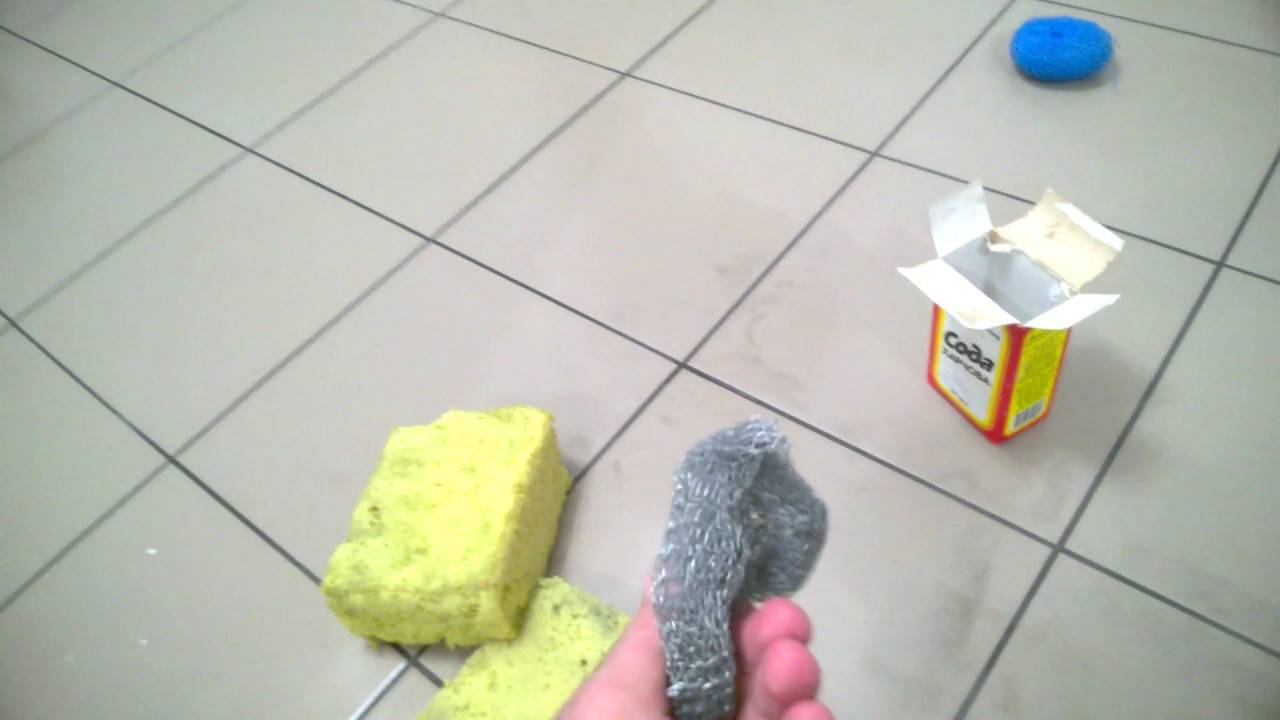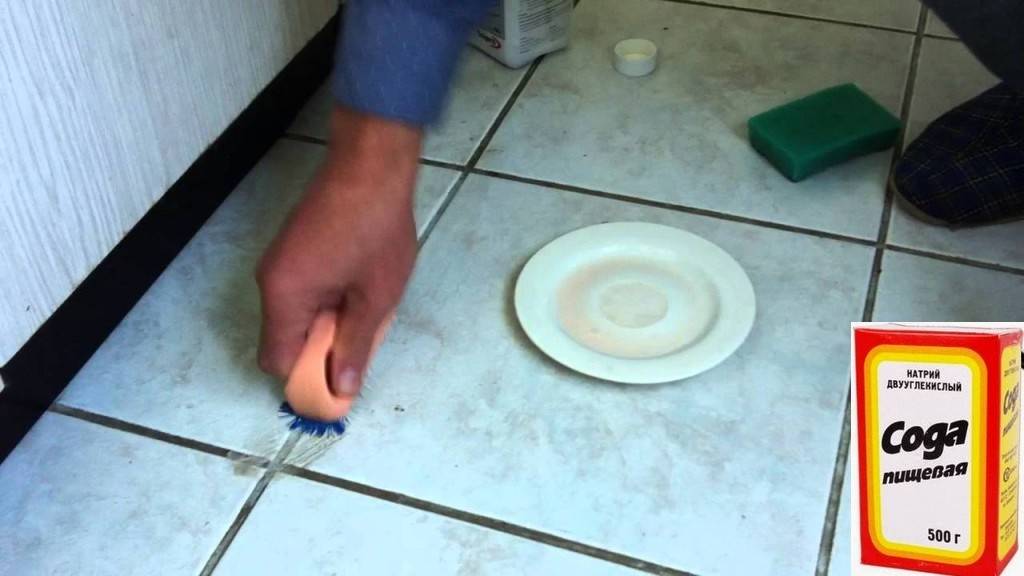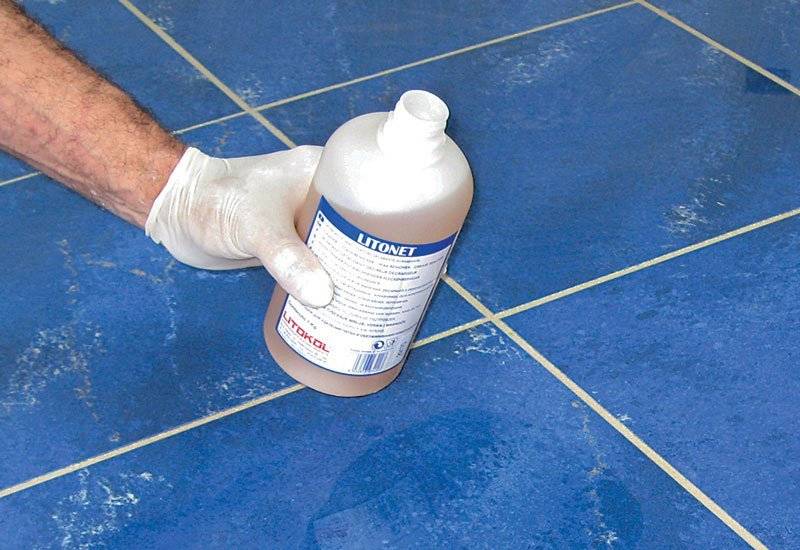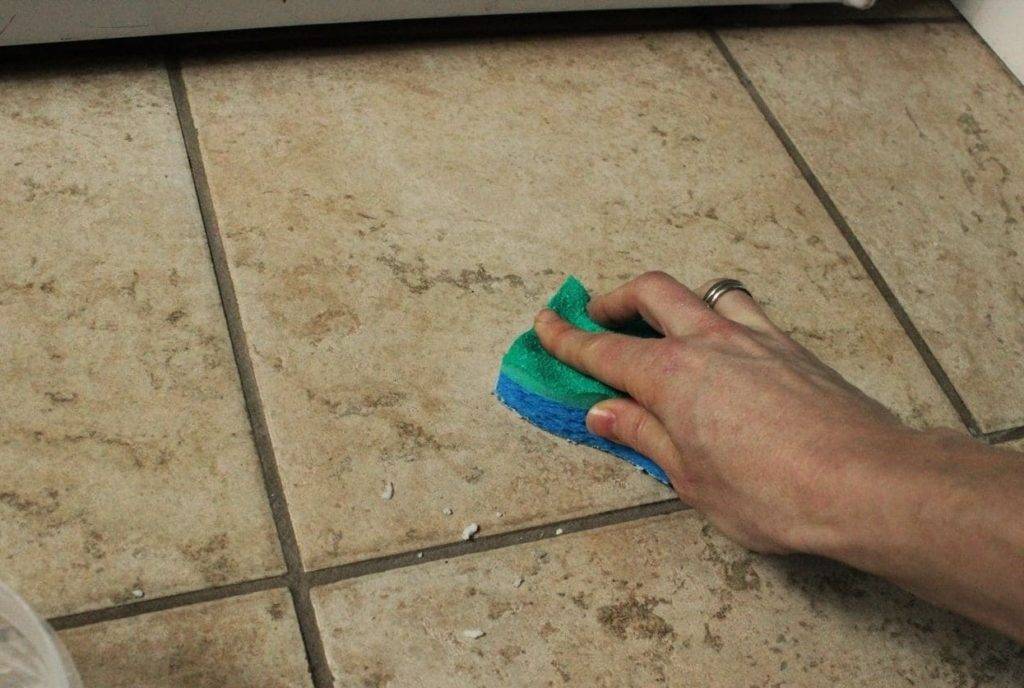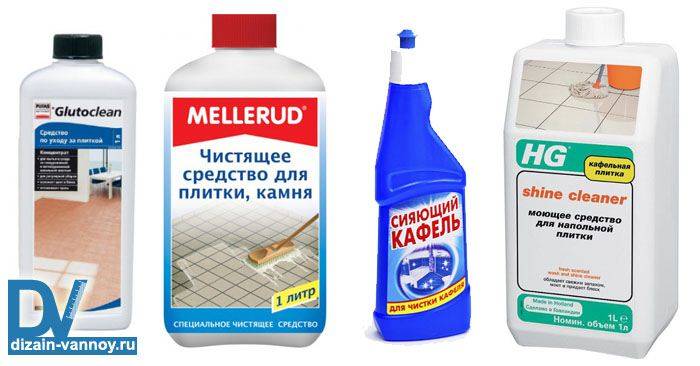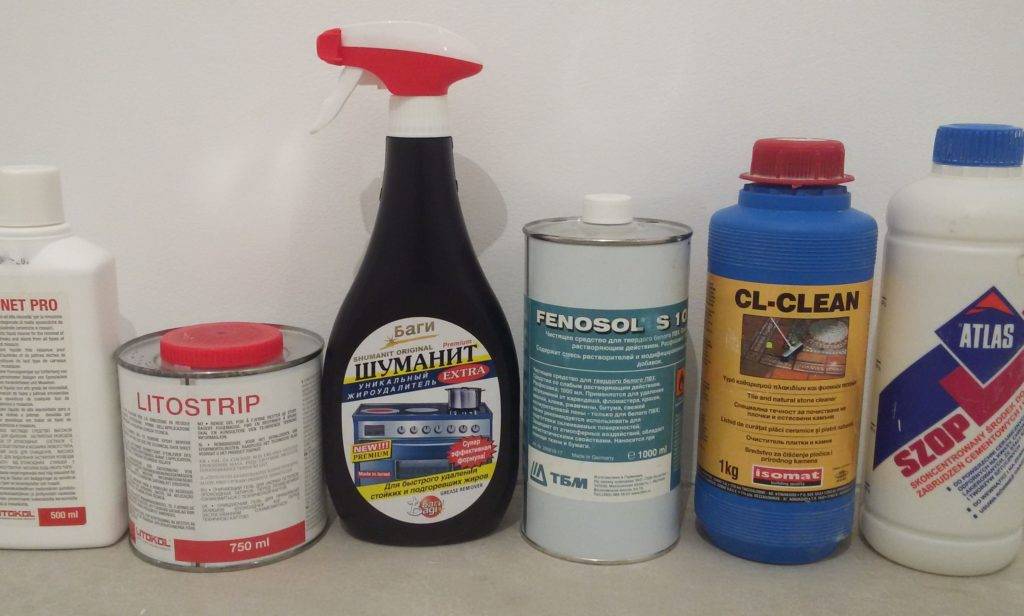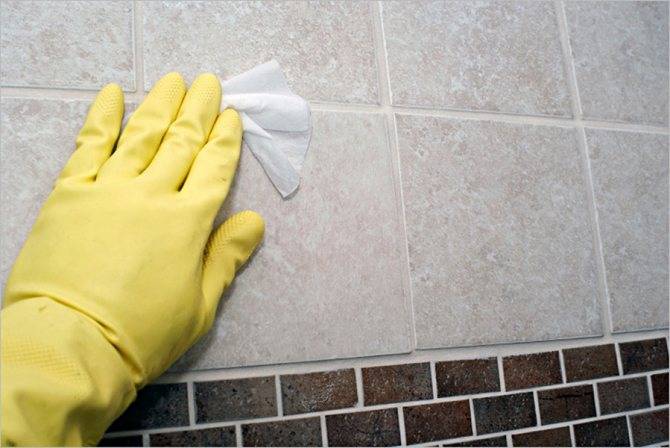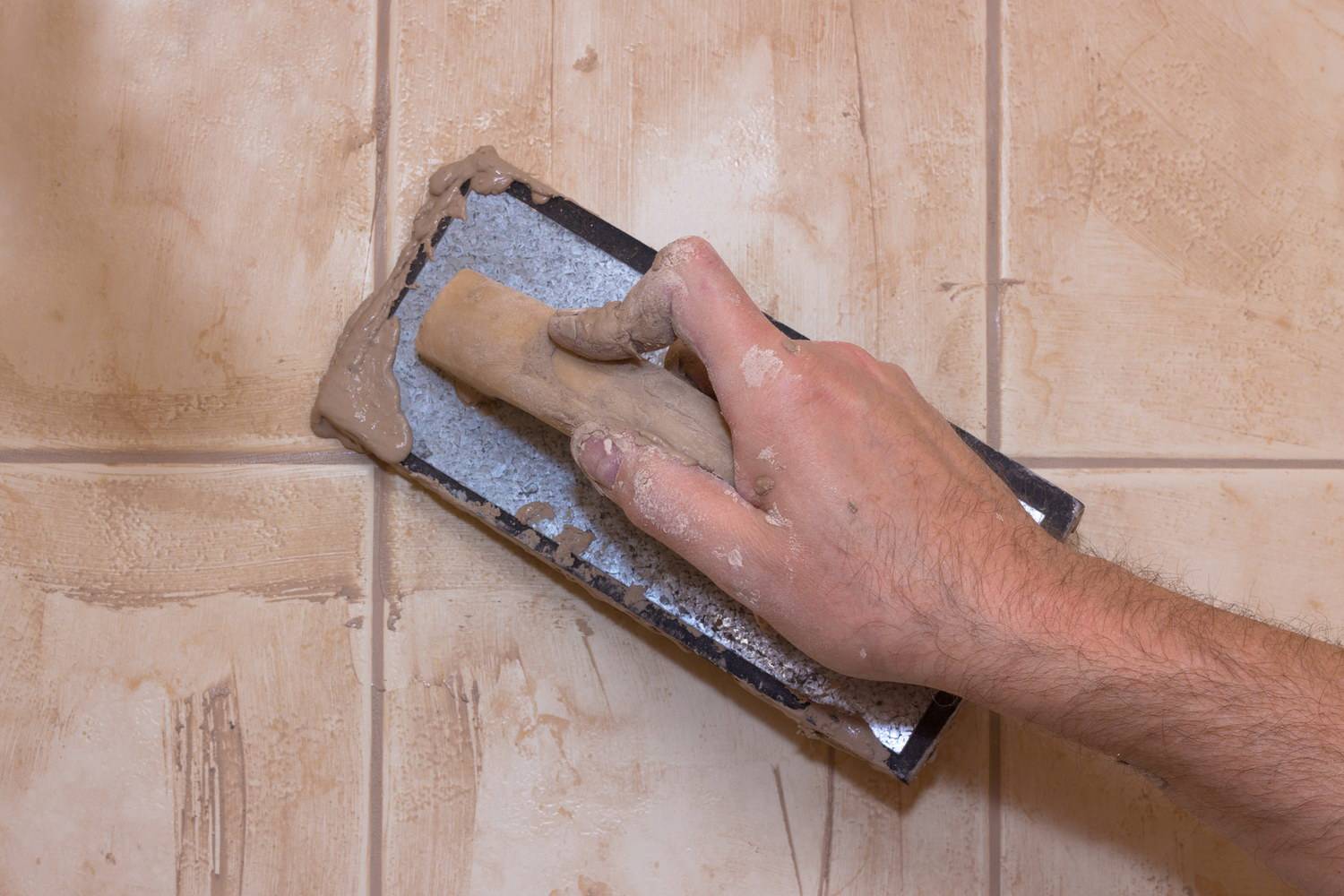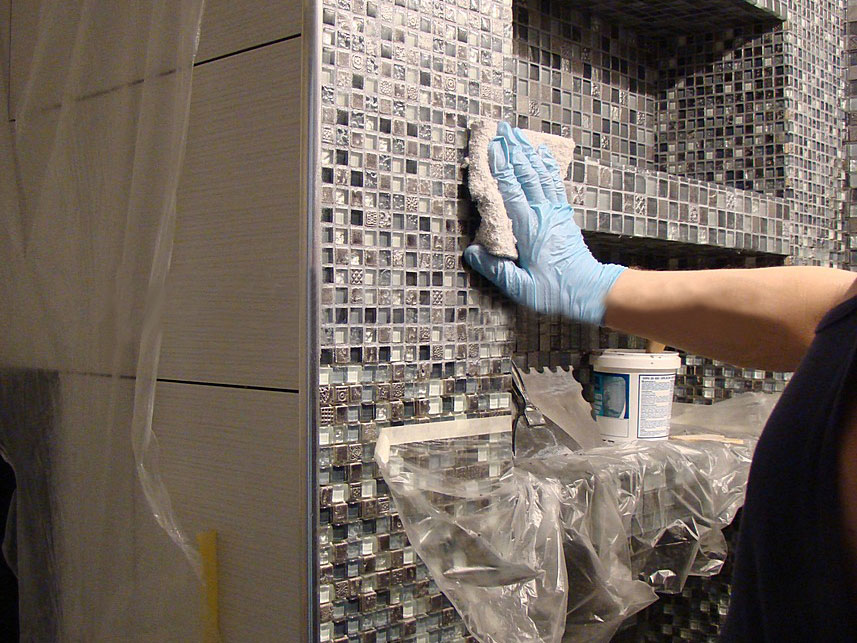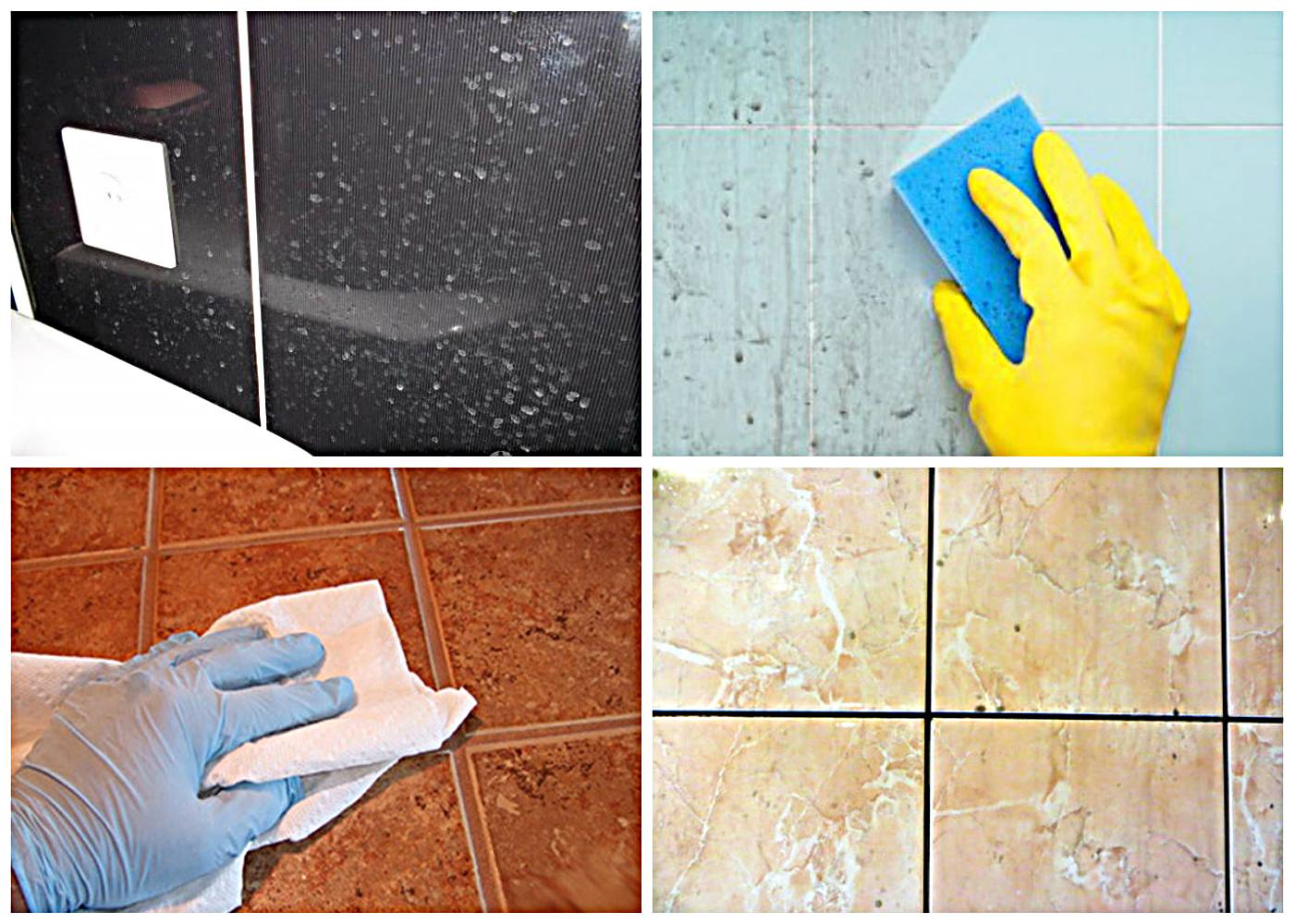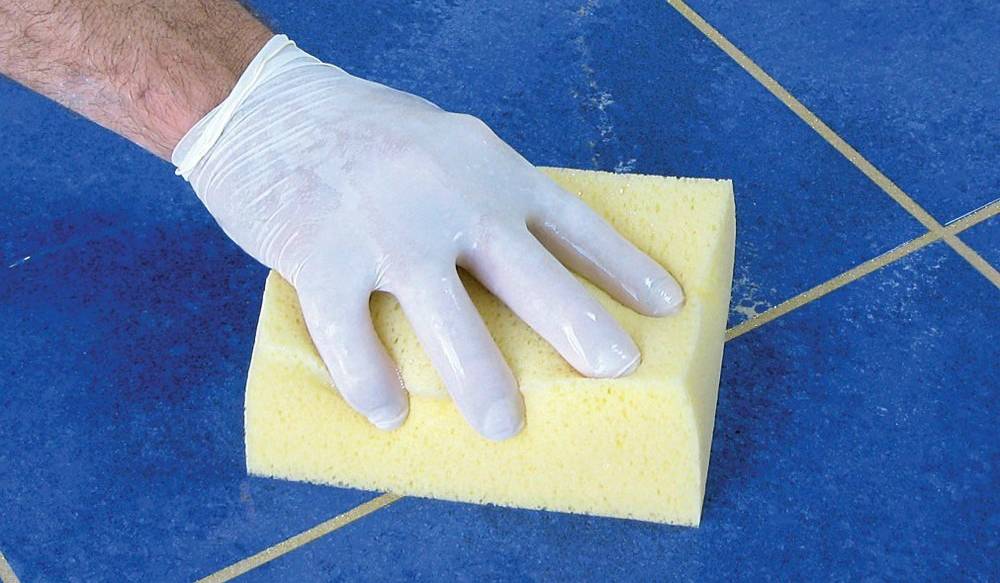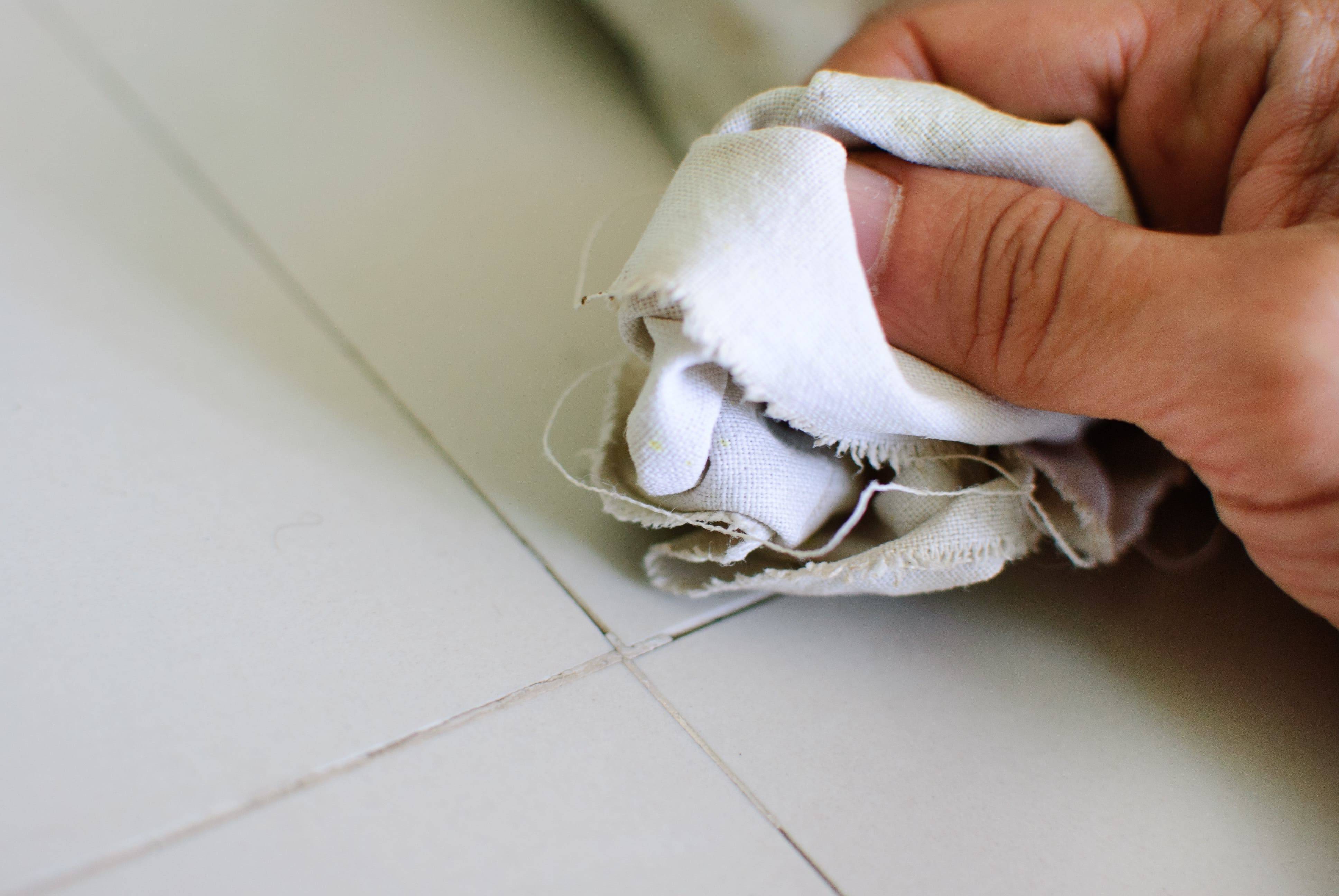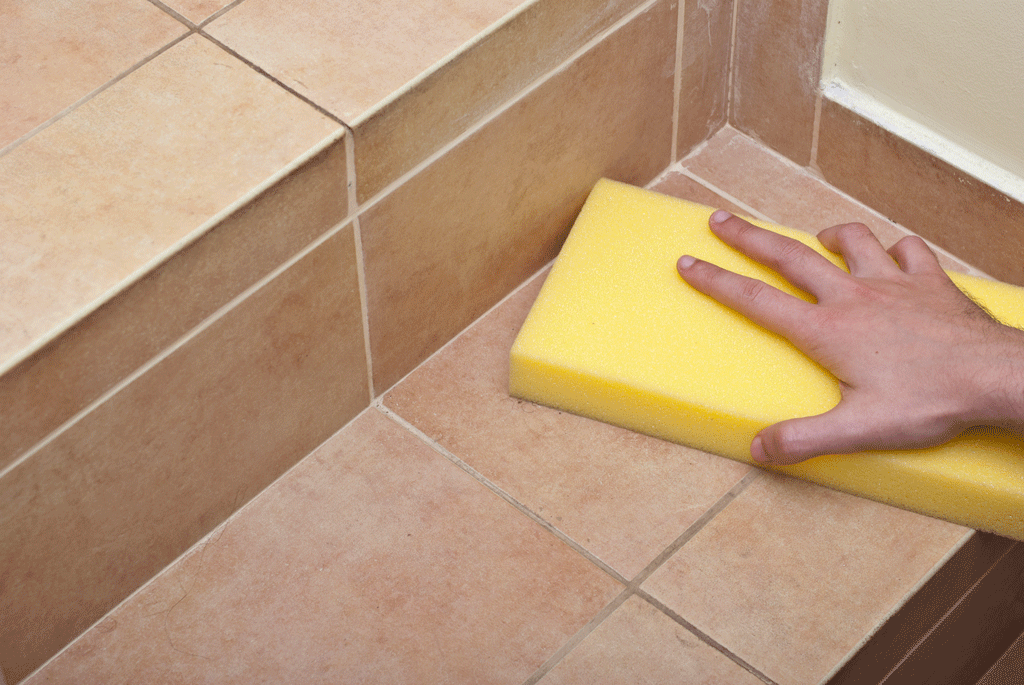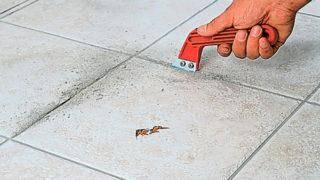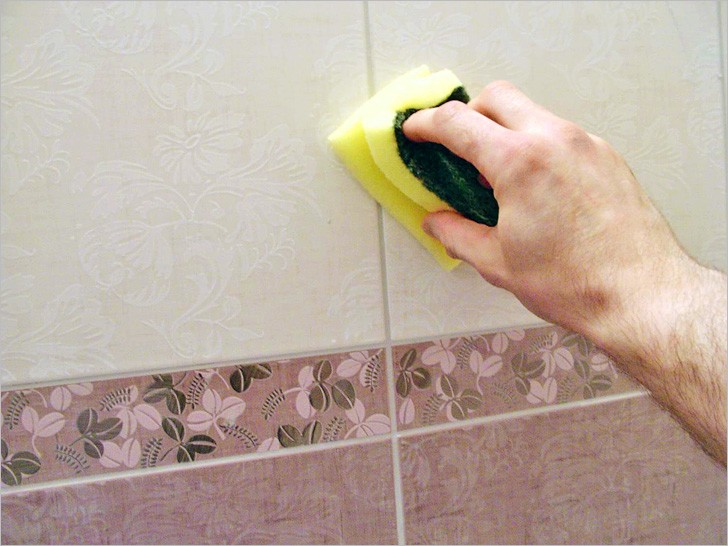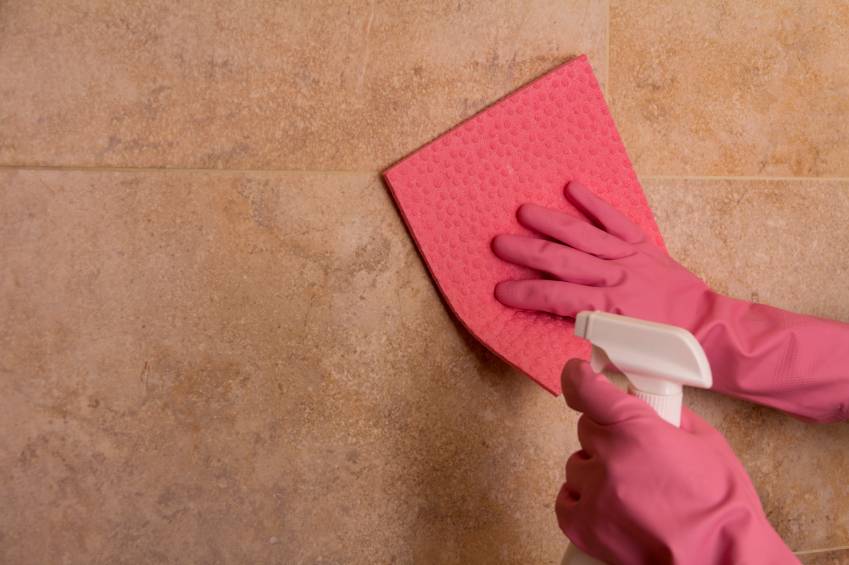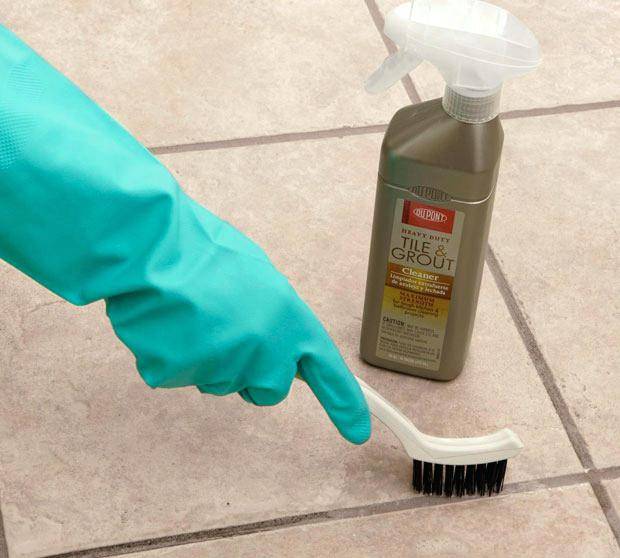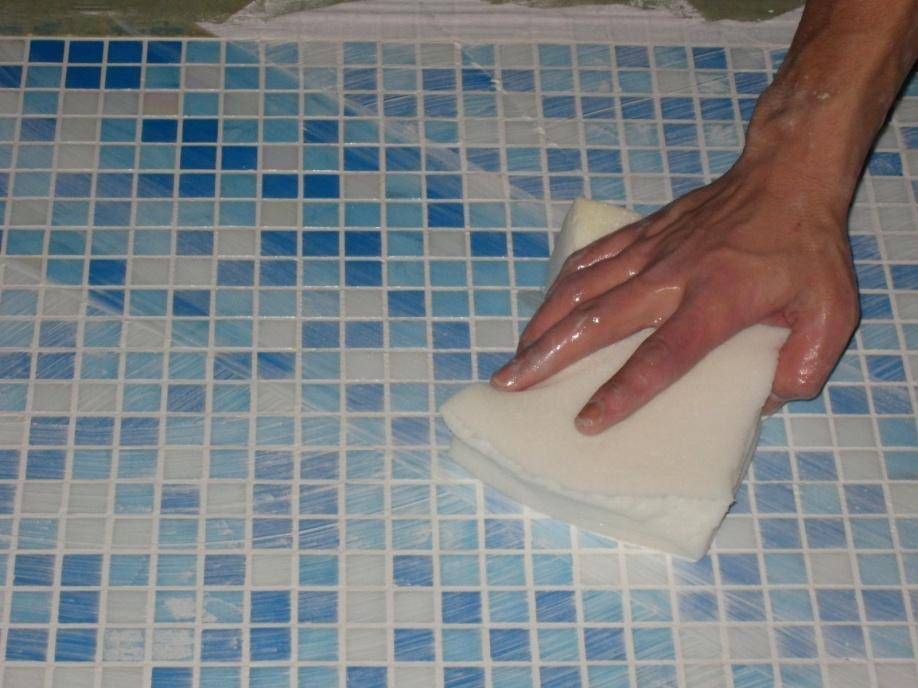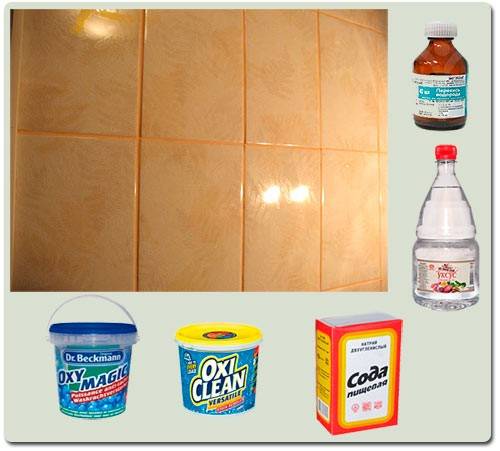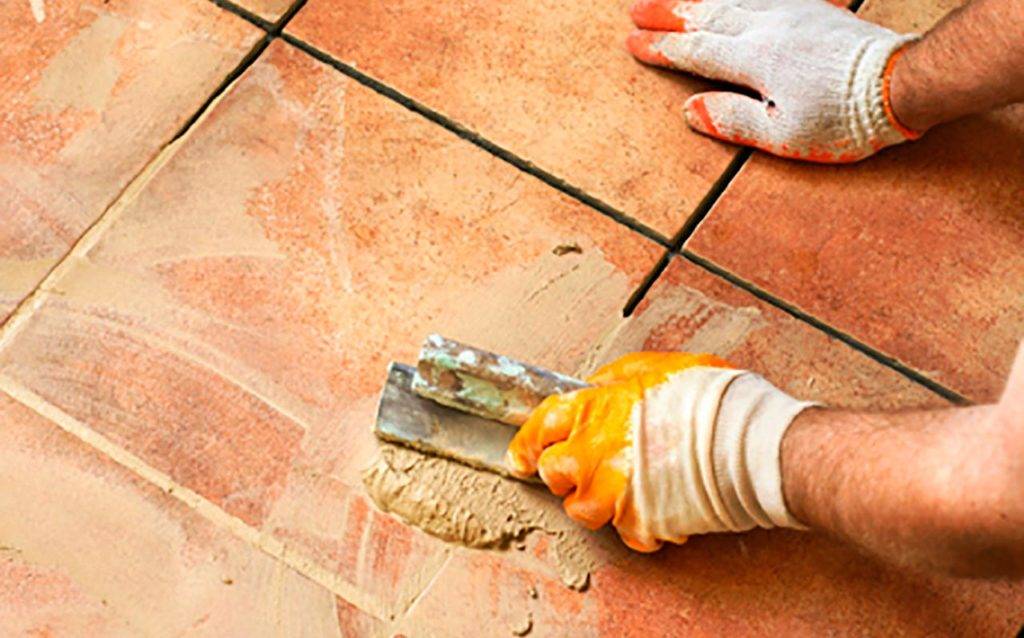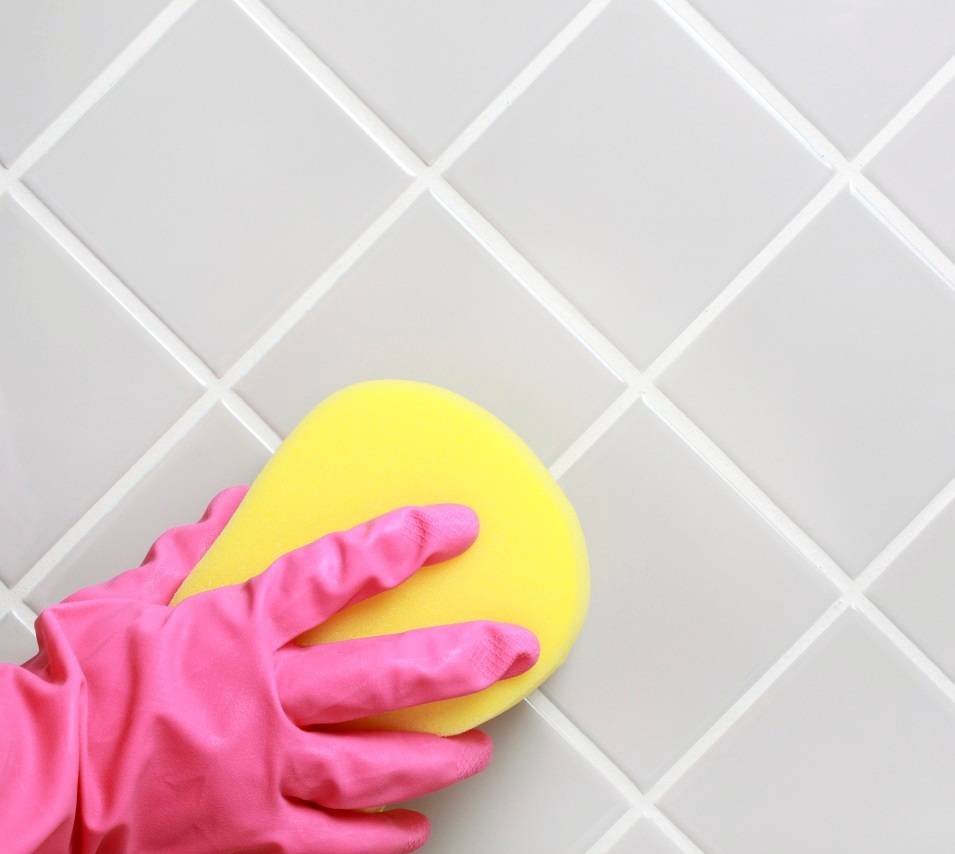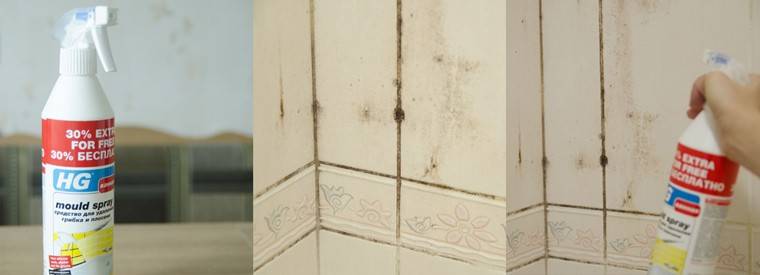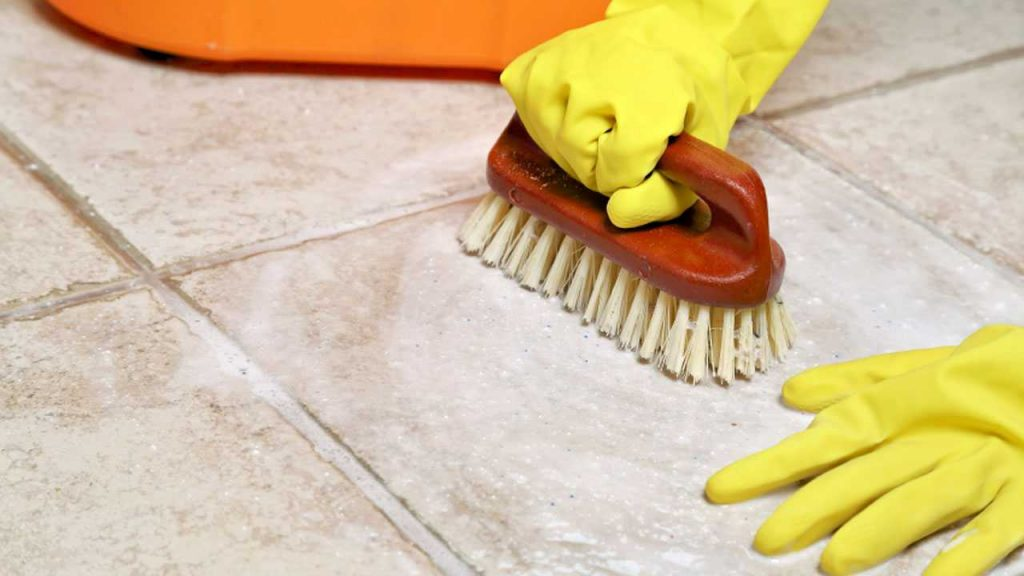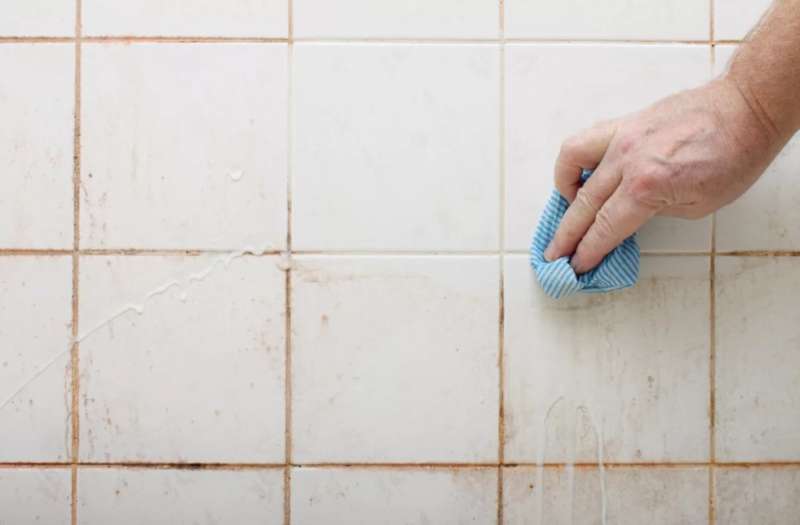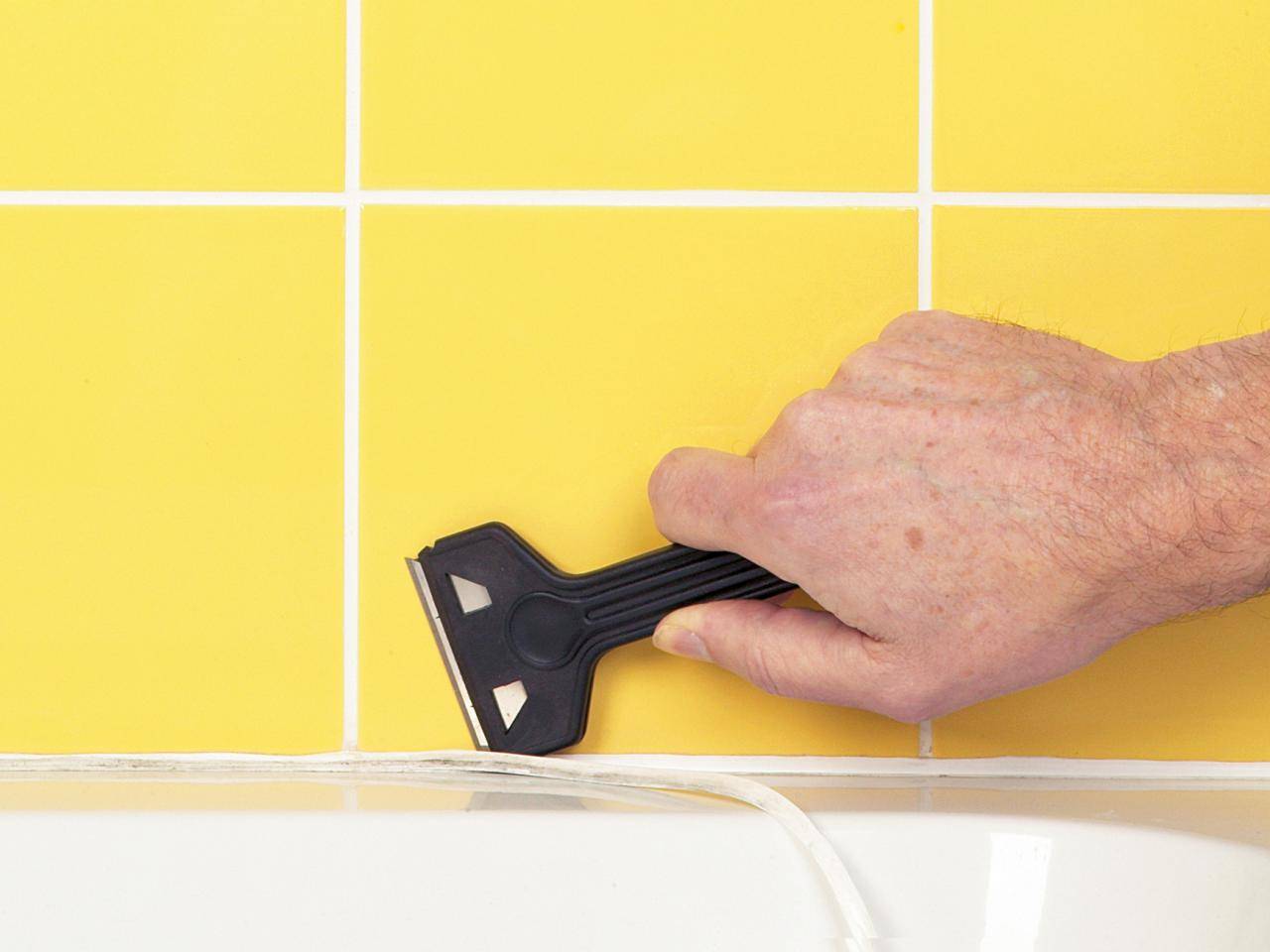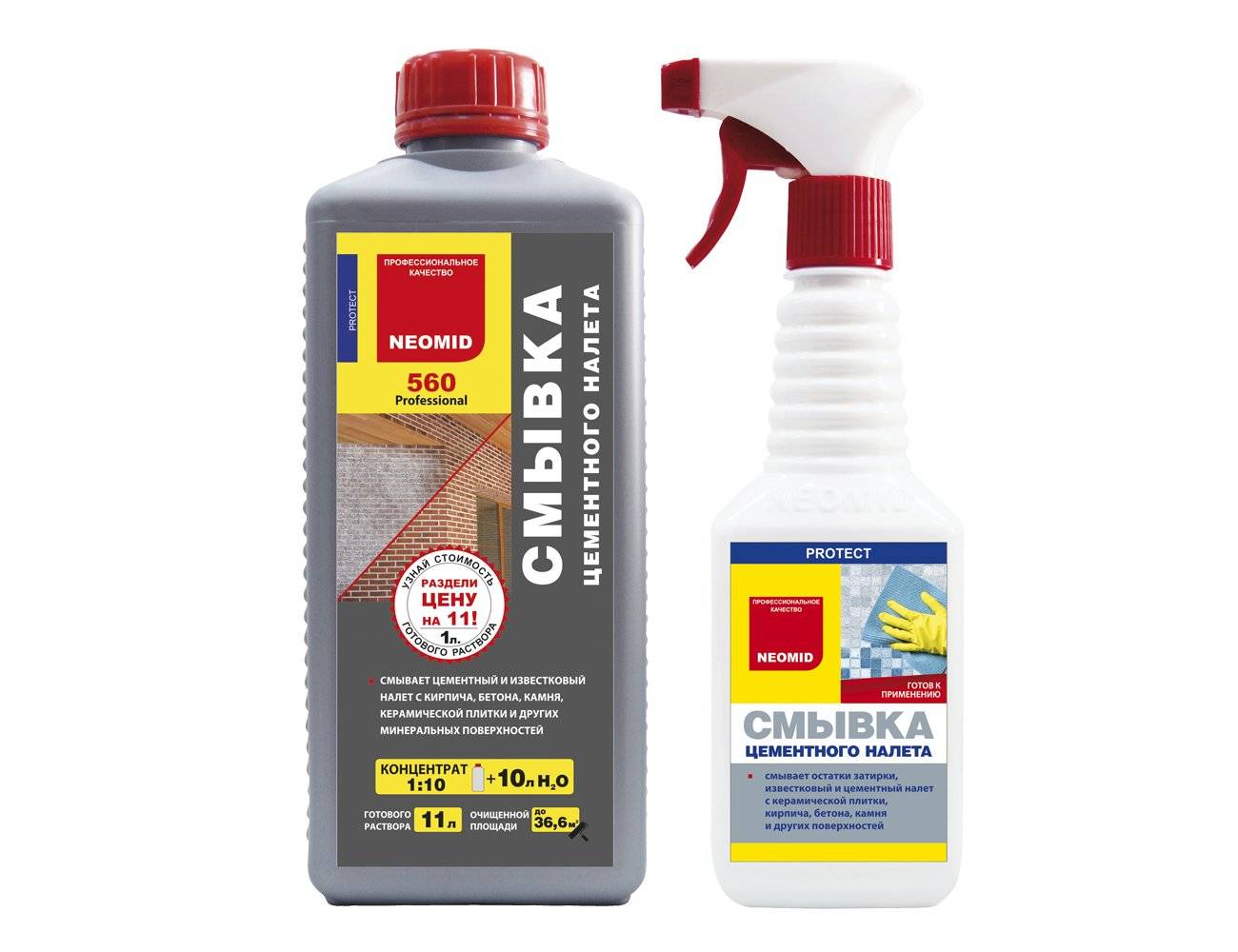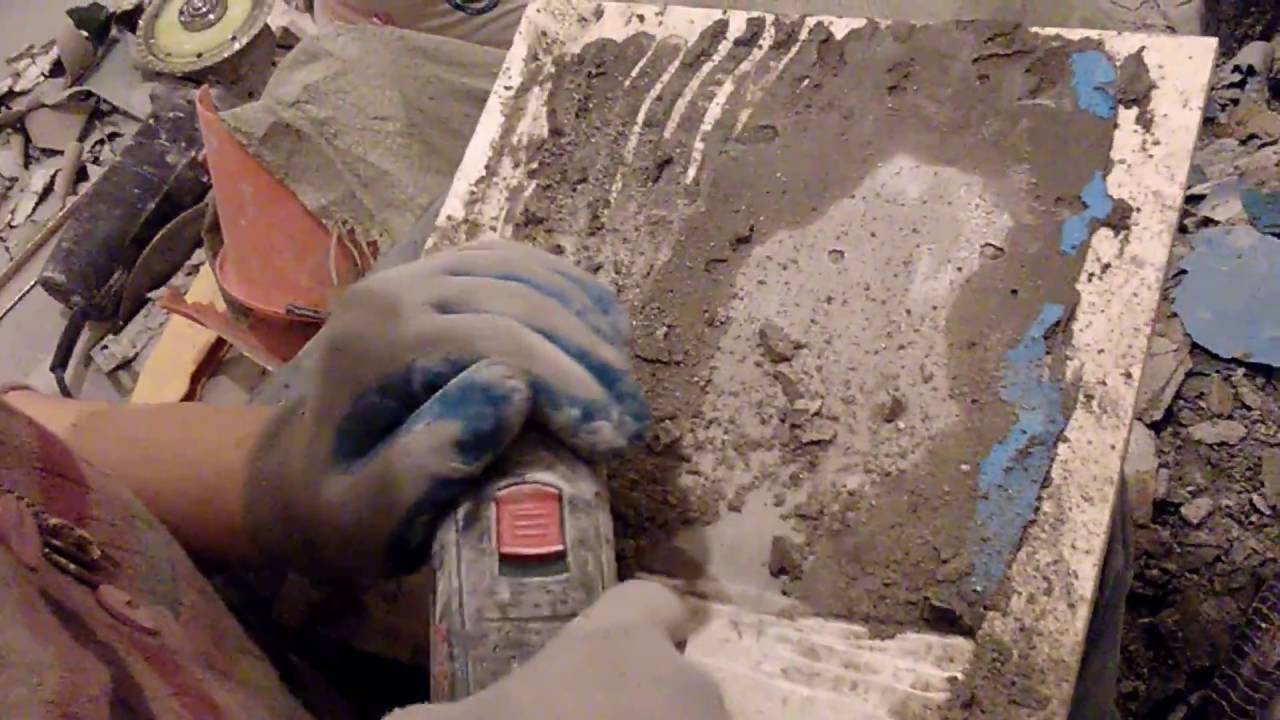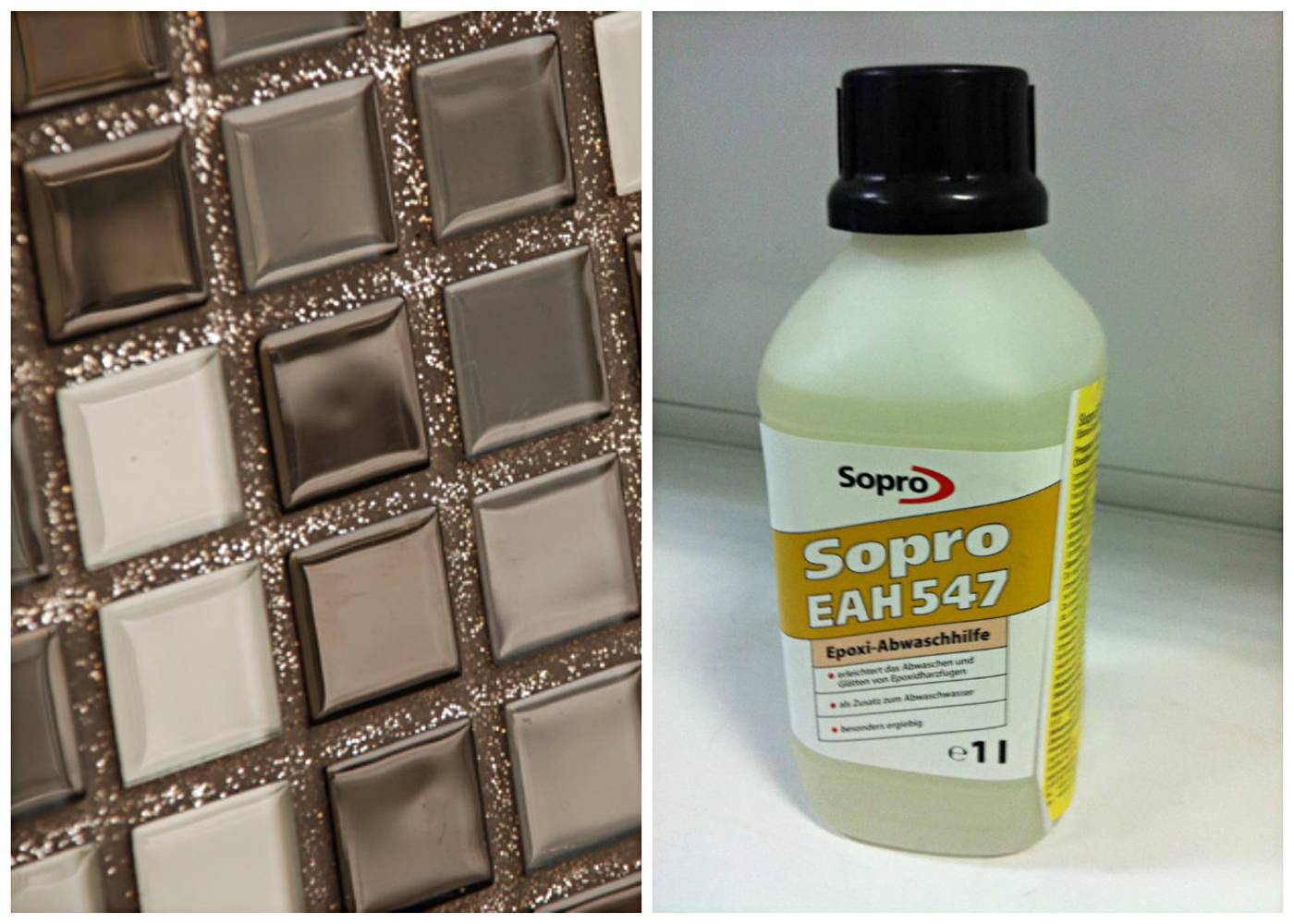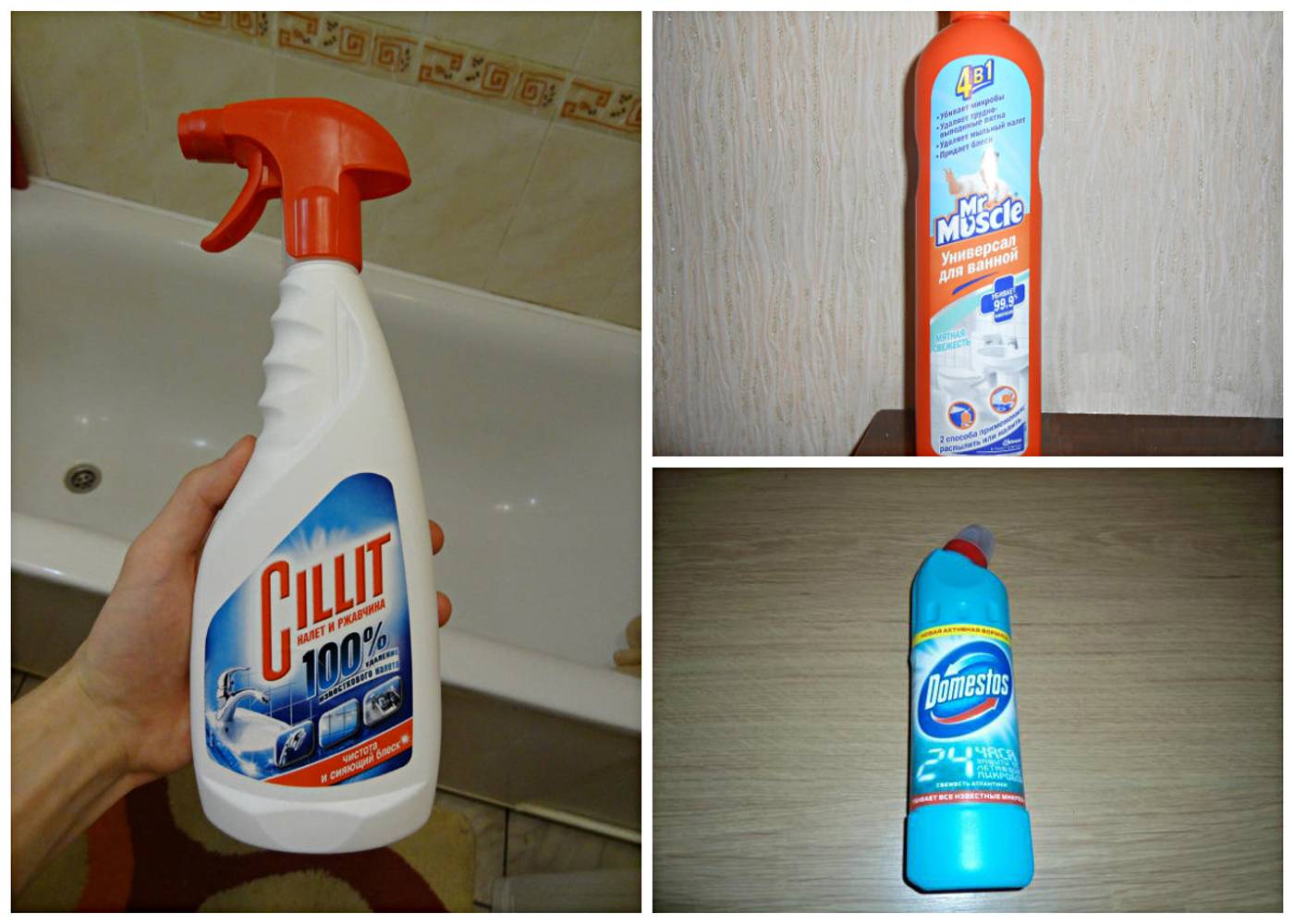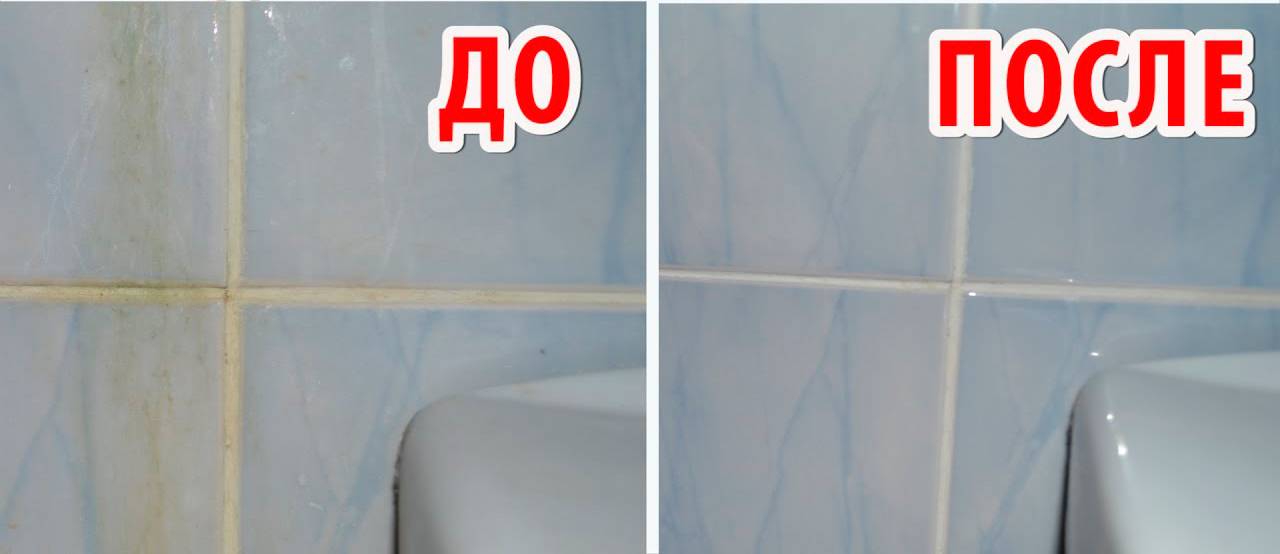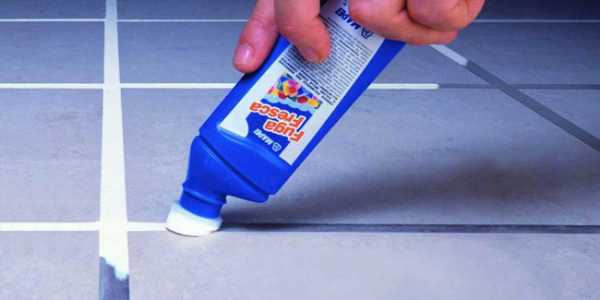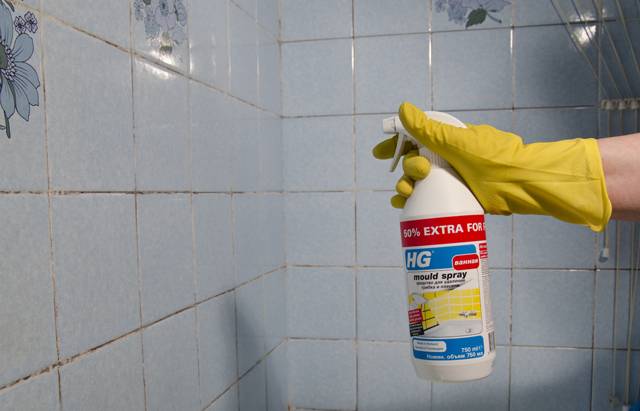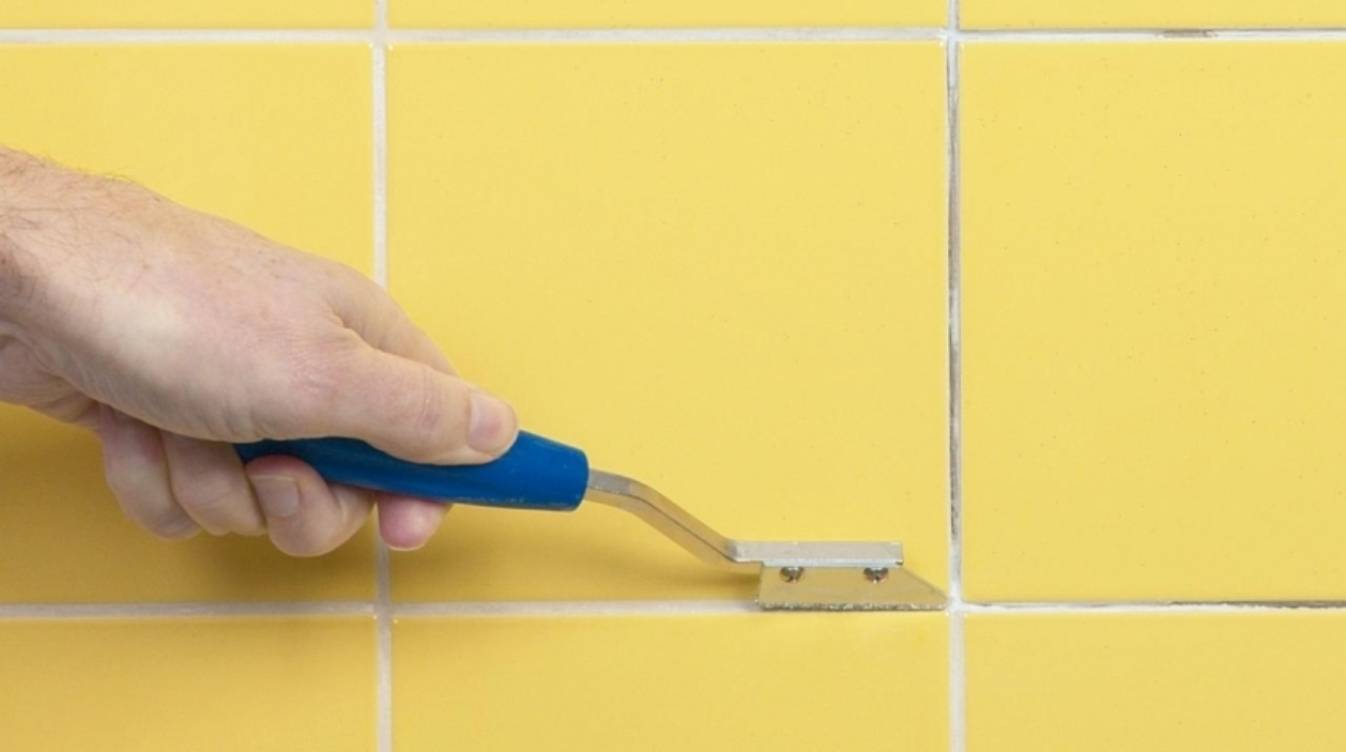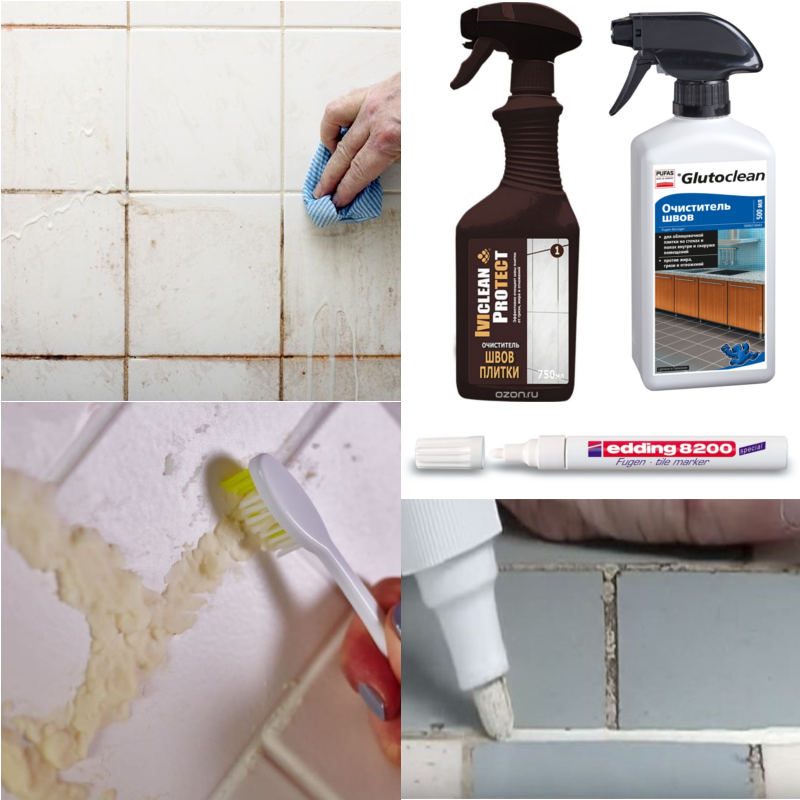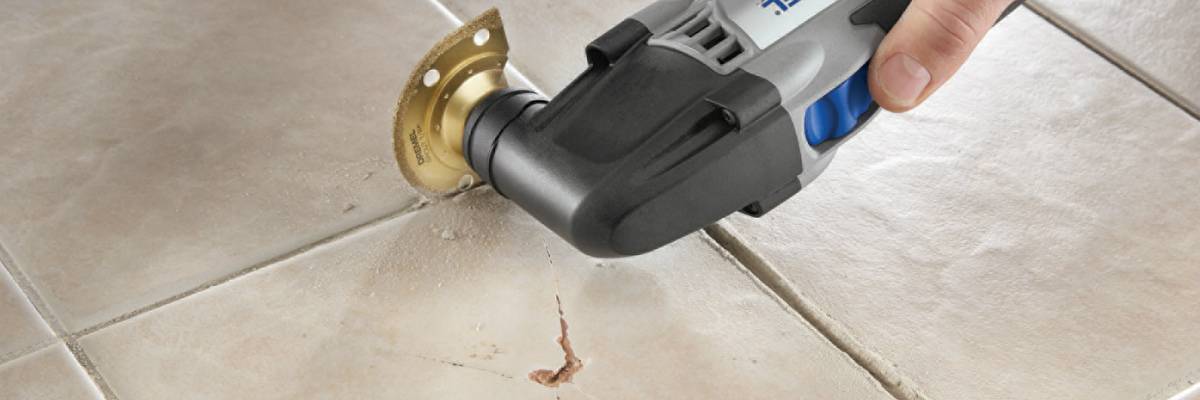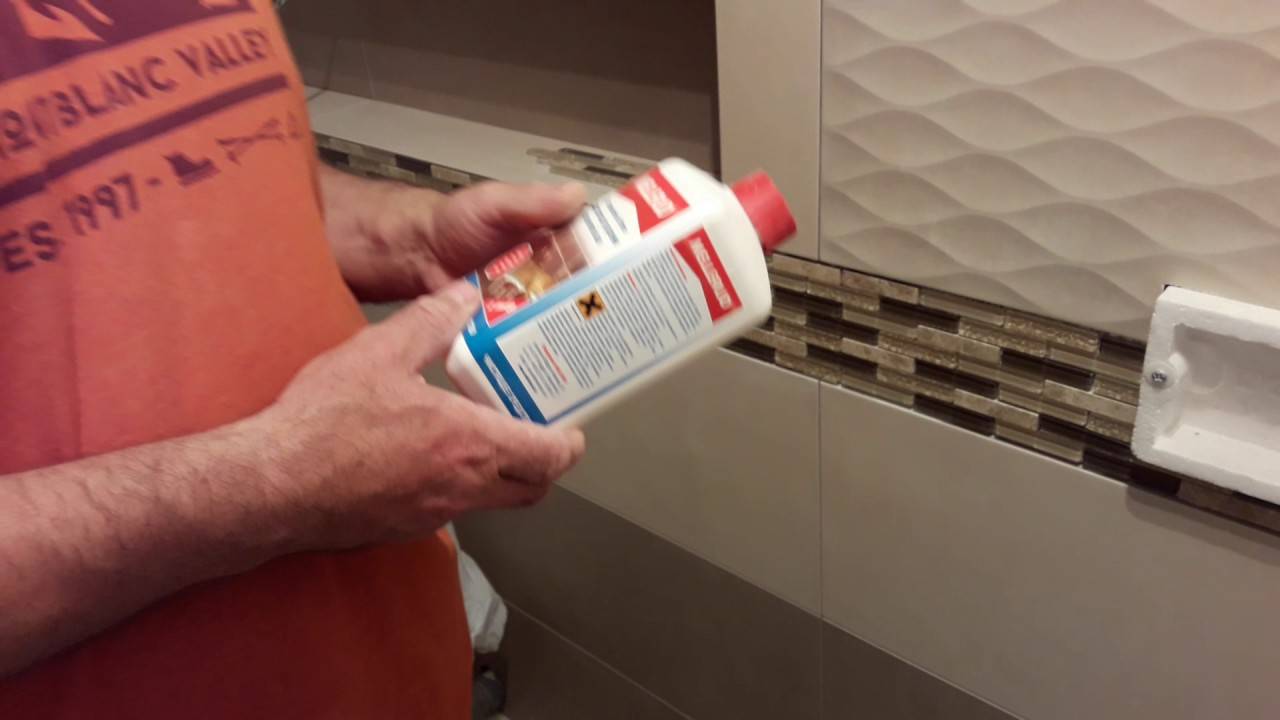How to clean grout after renovation?
In order to avoid problems of cleaning the grout from the surface of ceramic tiles, it should be remembered that such contaminants are most easily and quickly removed during the repair process, before the building mixture has time to harden.
After covering a small area, you should check how well the mortar has set and start removing dirty drops and marks on the ceramic surface. To check the condition of the grout:
- Lightly dampen the seam with a damp cloth.
- Observe the behavior of the material.
Important! Evaluate the result by the following criteria:
- If the grout began to swell and go beyond the boundaries of the seam, then this behavior of the building material indicates insufficient hardening and a low degree of adhesion.
- If, after soaking, you do not notice the changes, then everything is fine and you can start cleaning the surface from the remnants of building material.
Grout removal technologies
It is possible to wash the tile from grout after repair in two stages:
- Dry cleaning. This procedure is carried out after laying a small section of the tile by wiping the surfaces with a special float. The tool is held at right angles to the coating.
Important! It is recommended to carry out cleaning movements diagonally to the surface of the seams. It is this direction that will help you avoid damage to the grout that has not hardened to the end.
- Washing the surface. Wet cleaning of the tile surface should be started after the grout has partially hardened. For this procedure, it is recommended to use a piece of foam rubber, which is abundantly moistened with water.
Important! Remove the remaining dirt from the glossy surface with a hard cloth, felt or burlap. This procedure will avoid streaks on the smooth surface of the tiles.
3 tips from the master
On YouTube, I found the advice of Force-Montage professionals (almost 52 thousand subscribers) who helped me to cope with the problem.
A few tips from the master on how to clean grout from embossed tiles:
- Cellulose sponge. Epoxy grout must be removed with a cellulose sponge no later than 20-60 minutes after the end of the work.
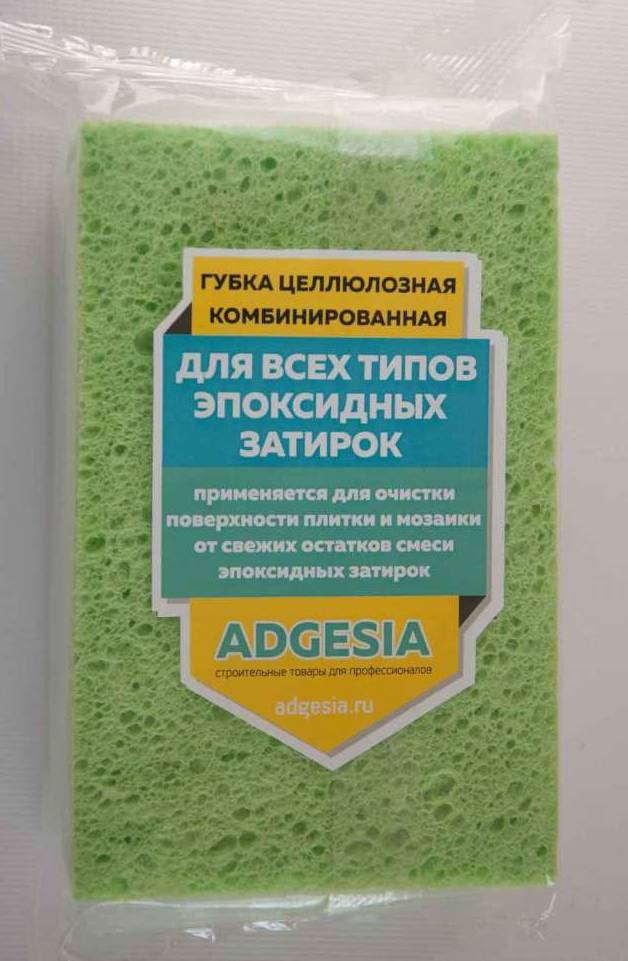 Look for this sponge in construction departments. She's not in the kitchens
Look for this sponge in construction departments. She's not in the kitchens
- Means "Sanitol". If the repair is completed, and the grout has dried to the surface and has eaten into the relief, the Sanitol product will help to effectively cope with the task. It is enough to apply to the surface for 20 minutes, then rinse with water. There will be no streaks or stains on the tiles.
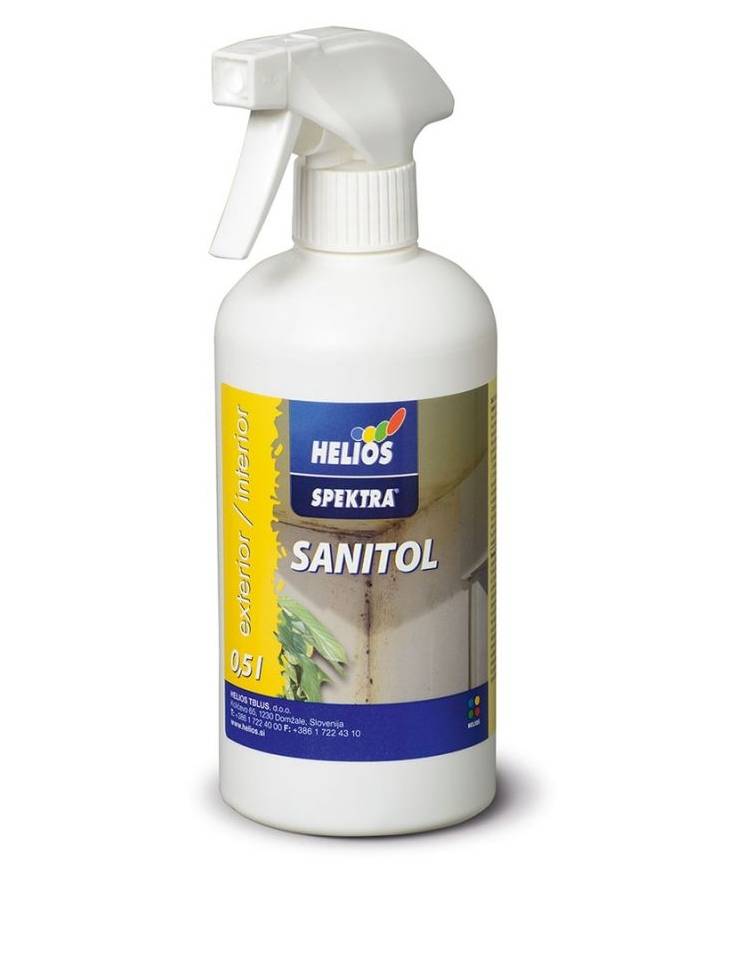 Professional remedy for difficult cases of contamination
Professional remedy for difficult cases of contamination
- Soap solution. Many types of grout can be cleaned with regular soapy water. Dissolve liquid soap in water, and wash off all remnants of a carelessly carried out repair with a sponge.
Improvised means
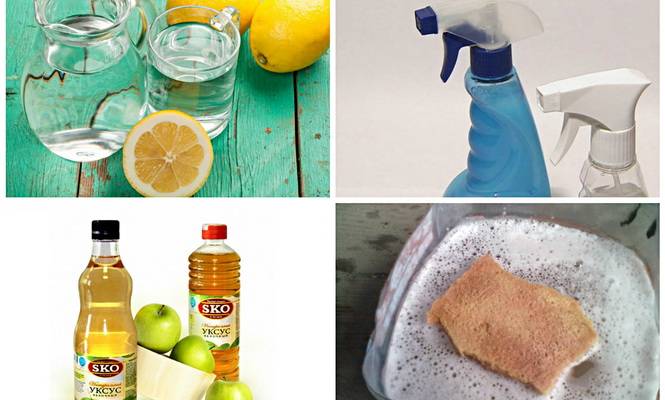
Let's figure out how to clean the grout from the tiles. The easiest way to do the work is if cement-based grouting was used during the repair. To remove them, you can use the following methods:
We take 100 ml for 2 liters of warm water. ordinary table vinegar (9%). Preparing the solution. Wipe the tiles with a soft cloth or sponge. We often rinse a rag or sponge in a solution and wring it out well, it should be damp, not wet. If the traces of grout have dried up and cannot be washed, you just need to apply a rag soaked in the solution to them for a few minutes, then scrape off the composition with a spatula, and wipe off the rest using a rough layer of a dish sponge.
- If in some areas of the ceramic coating there are the most "persistent" traces of grout, then it is worth applying soda gruel to them. To do this, stir the soda with water until a mass similar in consistency to toothpaste is obtained.We apply the gruel to the places of contamination, and after 20-30 minutes we wash off with vinegar water. This product is suitable for cleaning floor coverings, as the soda gruel will not stick to the walls.
- To soften the traces of old grout on the tiles, it is recommended to use diluted glycerin. It is mixed with water in a ratio of one to three and applied to the stained areas. After 15 minutes, the softened grout is carefully removed with a spatula, and the surfaces are washed with water. Similarly, you can use a soap solution prepared from 10 grams. grated laundry soap, and 0.5 liters of water.
- To wash away traces of cement grout on a tile, use a solution of ammonia. Prepare it from a liter of water and a tablespoon of ammonia. The prepared solution is used to wash the walls or floor.
Improvised means
With minor fresh contamination, you can use proven folk recipes that are always available at home.
Laundry soap
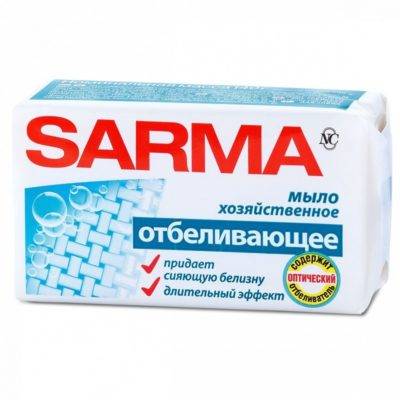
Laundry soap removes yellowness and whitens tiles well. It is enough to rub a brush or a washing sponge with a piece of soap and process the surface. The product gives a thick foam and stays on the surface for a long time. The applied soap is kept for 30-40 minutes, washed off with water and the tiles are wiped dry.
Vinegar
Acetic acid is successfully used to remove limescale from cladding. Vinegar is applied from a spray bottle or sponge. As a rule, the surface must be rubbed. If the plaque is relatively fresh, vinegar will remove it.
Combined with salt, vinegar is effective against rusty deposits.
A napkin or rag is well moistened with vinegar, dipped in fine salt and gently rubbed rusty stains. A water solution of vinegar is suitable for daily maintenance of tiles: the ingredients are mixed in equal parts and poured into a container with a spray bottle
The product can be sprayed daily on wall tiles and tile joints.
Baking soda or soda ash
Baking soda can remove grease, fresh rust, mildew, dirt and limescale. Before processing, the surface of the tile is moistened with water. Soda is poured onto a wet sponge and rubbed over the dirt. The product is left for 15 to 30 minutes. During this time, the plaque usually softens and is easily rubbed off with the hard side of a dish sponge or brush.
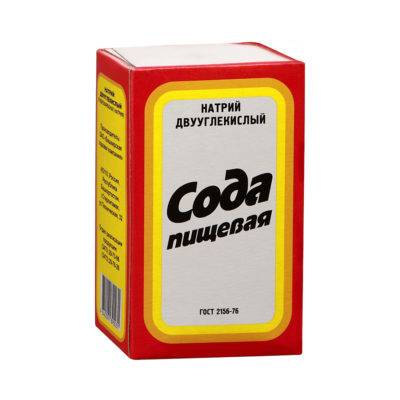
Hydrogen peroxide
Pharmacy 3% peroxide bleaches yellowed seams, colored spots or hair dye marks. On porous tiles, the stains will have to be treated several times. Peroxide is gradually absorbed into the pores and after 3 to 4 stains, it usually lightens or disappears noticeably.
Ammonia
Ammonia is often found in liquids for cleaning glass, mirrors and other glossy surfaces. By itself, it does not wash away dirt well, but it is added to prevent streaks after washing. An aqueous solution of ammonia (2 tablespoons per 1 liter of water) is suitable for finishing tiles after basic cleaning.
Lemon acid
Lemon or citric acid softens limescale and gives a slight whitening effect. Sprinkle the powder on a sponge and wipe the tile. Thus, you can wash the tiles from fresh plaque in 2-3 minutes.
Tea tree oil
Tea tree essential oil is known for its antibacterial and antifungal properties. It can be used neat or added to household and industrial detergents. Regular use of tea tree oil is a good prevention of mold.
Methods for cleaning ceramics from various contaminants
We will provide an overview of an effective method for cleaning tiles from the most common types of dirt, using both special means and methods of cleaning with improvised materials and substances.
Due to the fact that the cladding of the bathroom walls occurs after the installation of ceramics on the floor, there is a danger that the primer compounds used to prepare the wall surface for finishing come into contact with the fragments of the flooring. Wiping off the stains from the dried primer is a serious test of endurance and patience, so you should not let it get on the ceramic surface, and if this has happened, then spills should be removed immediately with ordinary water.
Since the tile is a material resistant to various types of adverse effects, many products are suitable for washing it.
The following methods are used to clean the dried primer:
- stains are dissolved with a special wash;
- the primer is washed off with acetone;
- contamination is treated with a liquid primer;
- use of vinegar essence.
To make the dried primer easier to remove, the contaminated areas are covered with wet rags, and some time is given to soften the dried stains.
Particularly difficult places can be cleaned mechanically, namely with a special scraper. It is a device consisting of a handle and replaceable blades. Pre-soaked spots, carefully so as not to damage the tile, are cleaned off with a scraper; the tool must be held at an angle of 30 degrees to the tile surface.
Unsecured cement mortar can be easily washed off with a wet sponge or cloth and clean water. But you will have to tinker with the frozen solution:
- Cleaning with special washes.
- Toilet bowl cleaner, copes well with dried cement mortar.
- Mechanical cleaning method. The traces of the solution are removed with a metal spatula or a metal dishwashing net.
We remind you that when using the mechanical method, the dried solution must be soaked in advance and when cleaning with metal objects, do not damage the surface of the finishing material.
After the repair, the cement tile should be cleaned immediately, before it has time to harden.
Tile adhesive
- Traditionally, the easiest way to promptly remove glue residues during installation is with a wet sponge.
- The frozen glue is soaked with a solution of water with vinegar or ammonia.
- Chemical treatment of contaminated areas with potent substances.
- Mechanical cleaning. The traces of glue are removed with a metal spatula, scraper, metal mesh or fine sandpaper.
Key moment. In “hopeless” cases of strongly adhered glue spots, it is advisable to use chemical and mechanical methods in combination.
To facilitate the process of cleaning the grout from the surface of the tiles in the bathroom, it is necessary to strictly observe the technology of finishing the joints with a grout, do not apply too much grout to the treated surface and remove its excess in time.
First of all, you need to remove traces of glue as soon as possible, especially if we are dealing with ceramic tiles.
There are two ways to delete:
- Chemical. The method is based on the use of potent, acidic substances. Using this method, it is necessary to take into account the properties of the ceramics used and its resistance to acids. Do not forget about safety measures when working with active substances, always using personal protective equipment.
- Mechanical. The method is used for cleaning heavily dried grout or joints that are resistant to chemicals. In this case, the following tools and devices are used:
- metal spatula, brush or scraper;
- various cutting devices with a sharp blade;
- sandpaper or metal abrasive mesh.
Construction dust
The most common and "obligatory" type of pollution after construction and repair work will be the presence of construction dust. Removing it is a simple process and does not require the use of any special and potent substances.
Dust must be cleaned as soon as possible to prevent dust and dirt from entering
First, the dust is removed from the surface with a dry cloth or with a vacuum cleaner, after which the wet processing of the cladding begins, for which the following means are used:
- warm soapy water;
- water with the addition of lemon or citric acid;
- vinegar solution;
- compositions for washing glass.
You need to wash ceramic tiles from top to bottom.
Rules for working with cleansers
Most fat removers, both home and commercial, can cause an allergic reaction, poisoning, or, if inhaled, burn the lungs.
To work with household and folk “chemistry”, you must strictly follow the safety rules:
- Cover your clothes with a long, tight apron;
- be sure to wear rubber gloves;
- do not lower your head low to the surface to be cleaned so that acid fumes do not burn your throat and lungs;
- read the instructions for the purchased product;
- remove all food from the table and kitchen countertop;
- make sure that children and pets do not have access to the kitchen.

After cleaning, wash your hands, face and neck very thoroughly, it is even better to take a shower with shampoo and soap. Rinse the gloves thoroughly, machine wash the apron. It is better to throw all your clothes into the washing machine immediately after cleaning the kitchen.
Before starting work, it also makes sense to make sure that a window is open in the kitchen, and if possible, you need to turn on the hood. Inhaling vapors from household chemicals or vinegar is not worth it - they can cause a real burn of the larynx and mucous membranes.
After washing the tile, the window must be left open in winter for at least 30 minutes, in summer - for two hours, so that all poisonous fumes are carried out into the street.
How to clean fresh grout from tiles
The grout is best removed during the grouting process, alternating between grouting and cleaning. After completing a small amount of work, you need to check if the solution has set and start cleaning dirty traces. To check the condition of the grout, slightly moisten the seam with a damp cloth and observe what happens next. If the grout is swollen and begins to crawl out of the seam, it means that it has not grabbed enough. If there is no change, the leftovers can be removed.
When the volume of the cladding is small, cleaning can be started after all grouting is complete.
The process looks like this:
- Moisten the sponge with water and wipe the surface;
- Remove solid residues of grout with an abrasive that does not scratch the surface;
- Rinse the sponge until it is clean and wipe the tile again.
During cleaning, it is important to monitor the moisture content of the sponge and to remove excess water that can wash away fresh grout. Glossy tiles can be cleaned the next day after mashing
Glossy tiles can be cleaned the next day after mashing.
How to remove dried grout from tiles
To remove mortar hardened in porcelain stoneware pores or from glazed surfaces, there is an acidic cleaner to remove cement residues. Its composition is capable of reacting and dissolving traces of glue, grout and cement on the tiles. The product is applied to the surface for 5 minutes, then washed off several times with water.
Features for removing epoxy grout
Cleaning of tiles from grout containing epoxy resin should be carried out as soon as possible after processing the joints. There is an epoxy cleaner for this. The epoxy dissolver consists of several acids and is quite expensive. But still cheaper than re-purchasing the material and new facing work.
If more than 24 hours have elapsed and the grout has hardened completely, the tiles can only be cleaned mechanically.
Tools for cleaning tiles
In addition to ready-made products specially produced for removing dirt from tiles, there are common household cleaning products:
- Detergents containing acid - you can find out about their composition from the label;
- Limescale removers are a proven way to clean grout from tiles;
- You can add 1 spoonful of white spirit or kerosene to the water;
- A mixture of water with glycerin (3/1) - eliminates cement stains on tiles;
- Rubbing the tile with baby soap before rubbing the seams protects its surface from contamination. After finishing the work and drying the joints, the tiles must be washed.
It should be noted that it is better to start the experiments with the removal of dirt with a separate tile left over from the repair. If a satisfactory result is obtained, the proven product can be applied directly to the veneer.
5 General tips for cleaning tiles
To ensure high-quality and safe removal of contaminants, we advise you to adhere to the following professional recommendations during the work:
- 1. Cleaning work can only be performed with gloves and a respirator, especially if powerful chemicals are used that can cause allergic reactions or chemical burns on the skin.
- 2. If vertical surfaces are cleaned of grout, then it is best to start cleaning from the bottom and move up. And it is better to wipe the cleaned wall with damp rags from top to bottom.
- 3. In order not to damage the grouting joints during cleaning, it is necessary to first protect them with epoxy paint or masking tape.
- 4. Before using household chemicals, it is necessary to study the instructions from the manufacturer and strictly follow them. Any violations can negatively affect the quality of cleaning.
- 5. If the grout in the tile joints has darkened, you can use a solution of hydrogen peroxide to clean it, which is applied to the joints and does not wash off.
Removing cement and grouting contaminants is a demanding job, if done incorrectly, you can not only not achieve any positive results, but also harm the facing materials. Therefore, it is not recommended to use untested means and methods, even if they are advised to you by good friends and close people.
How to scrub grout - modern methods
The young and advanced generation of tilers does not welcome folk methods and is guided in their work by the recommendations of ceramics manufacturers. But in their principled approach, they also forget that folk recipes are at the heart of all modern cleaning products for ceramic coatings.
The cleaning liquid must be applied to the tiles and then removed after a certain time with a sponge.
The acid-base component predominates in the detergents and cleaning agents of the current chemical industry. Here are some groups of such funds:
- protective: they are applied a few hours before the grouting process and after the end of the work they are removed by washing off together with the remains of the fugue;
- cleansing: applied on an uncured grout mixture by applying to the wall with a sponge;
- removing: used to remove already hardened grout by applying and holding for a certain time to soften the places of contamination.
When working with both recipes of folk craftsmen, and with modern cleaning products, it is necessary to adhere to certain rules.
- Before starting to use a product, check its effect on a sample of the tile you are going to work with. This will keep the entire cladding free from possible damage and unwanted cleaning results.
- Use personal protective equipment, at least special gloves and a respirator when working with acidic solutions.
- In your work, use not available tools, but those tools that are intended for a particular operation.
- Observe the sequence of operations and the technology of using the cleaning agents. This is especially true for factory production.
With proper care of ceramic cladding, it can last for more than one generation, as it is one of the most resistant finishing materials to external factors.
Recommended cleaning times
The removal of the trowel is carried out in several stages - from the primary elimination of excess to dry and wet cleaning. It is better to carry out the first stage when the material has not yet hardened, but has hardened enough. In this case, the risks of damaging the surface of the tile and disrupting the hardening process of the putty are minimized.
It is easy to check the condition of the seams - just moisten them with a damp cloth and evaluate the reaction.
If, after interacting with the liquid, the grouting mass began to increase in size and go beyond the seam, it is too early to start cosmetic work. If the layer remains unchanged and does not react to water in any way, the moment for cleaning is the most suitable.
Reference! The average initial setting time for tile grout is about 30 minutes.
Cleaning products
To care for the tile surface, the easiest way is to use ready-made special products that are sold in household chemicals stores. They are ready to use and do not need to be diluted or mixed with other substances. However, there are no universal ones among them, so you should carefully study their purpose before buying.

A good product should meet the following requirements:
- Be gel or liquid. The use of powders and abrasive pastes is best avoided as they spoil the glaze layer, and over time the tile will lose its shine, the gloss layer will be erased irrevocably.
- It is desirable that it contains chlorine. This component makes the tool almost universal, since not only helps to deal with various pollution, but also destroys bacteria and unpleasant odors.
- Does not contain chalk. Many housewives have long abandoned the use of chalk for cleaning tiles, because it will take additional time and effort to wipe off the white coating on the tiles.
- Does not contain acids. Their effect destroys the layer of putty and grout in the joints.
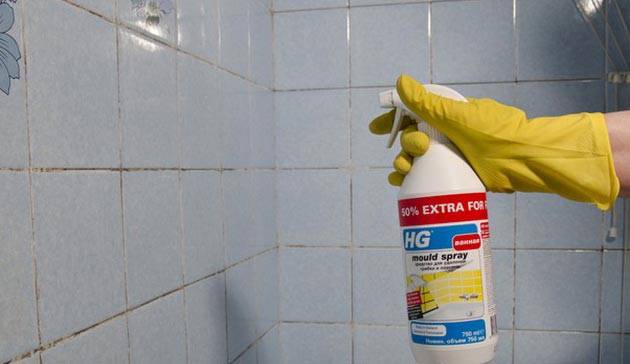
How to care for your tiles
In order for the coating to last for a long time, you need to know how to properly care for the tiles.
For glossy structures, do not use strong acid-based detergents. This can damage gaps and seams between products.
It is best to purchase specialty products for tiles, stoneware tiles and porcelain stoneware.
Do not use metal brushes or abrasive powders, as they severely scratch the surface of the coating. This is especially noticeable on glossy ceramic tiles.
The best tile cleaners
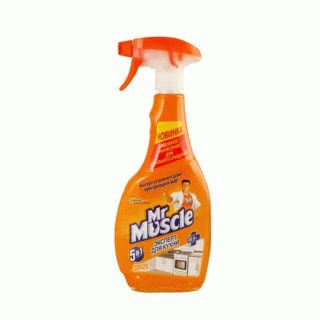
In order for the tile to retain its attractive appearance for a long time and not fade, it is better to use specialized mild detergents:
- Mister Muscle. Eliminates plaque, rust, removes stains from the surface of the tile and gives it shine. It is necessary to apply the liquid to the dirt, wait 3-5 minutes and walk again with a damp sponge. Copes well with stubborn stains and does not run off vertical surfaces. In this case, you do not need to scrape and rub the plaque with a washcloth. The detergent perfectly removes even the formed mold from the grout.
- Frosch. Suitable for most types of tiles. Effectively removes dirt, grease, streaks and plaque from ceramic tiles. Frosch is harmless to the body. The product neutralizes unpleasant odors and kills germs. To clean the tiles from dirt, dilute 2 caps of detergent in 5 liters of water and clean the surface. Not intended for pure use.
- Cif Anti-plaque. Removes accumulated dirt thanks to a unique water and dirt repellent formula. In a matter of seconds, it removes limescale and soap stains from the surface of the tile. Sif should be applied evenly to dirt, wait 5 minutes and rinse with clean water.
- Domestos. Effectively removes fungus, whitens grout joints and disinfects. Method of application: Dilute 2 caps of gel in a five-liter bucket of water and remove dirt with a sponge or soft bristled brush. Then rinse the surface with water and wipe dry.
- San wedge (Santik). Liquid for removing limescale, rust and other dirt from tiles. It must be applied to the surface for 5-10 minutes and then remove the remnants of dirt.
Also, you can use auxiliary products for cleaning tiles:
- Bleaching powder.Dilute the powder with clean water. Pour the solution into a spray bottle and spray it onto the desired surface. Then leave for five minutes and rinse with plenty of clean water. Allow the ceramic to dry or wipe the surface with a dry cloth. The chlorine solution kills germs and gets rid of mold.
- Melamine sponge. Easily wipes off small dirt, removes limescale and does not spoil the appearance of the cladding. You just need to wet the sponge and rub the dirt.
- Steam cleaner. A gentle alternative to aggressive cleaning fluids. Steam cleans the surface of the tile as well as chemistry. And at the same time it does not have any mechanical effect. The steam supplied under high pressure liquefies grease stains on the tiles and disinfects the surface to be cleaned, killing microbes. The steam cleaner is excellent at fighting mold and limescale in the bathroom. It removes even grease stains in the kitchen with ease.
To prevent the ceramics from fading and scratching them during operation, they need to be treated with a special varnish. A durable protective coating is created, the color does not change for many years, and the maintenance of the tile surface is greatly simplified, because almost no dirt accumulates on the varnish.
With proper cleaning and good timely maintenance, ceramic tiles will last for many years.
Removal of non-difficult contaminants
In the presence of severe dirt and such that are not even stained, but lumps, a spatula will do. It is necessary to remove the nodules, carefully prying each one. The main thing is not to rush and perform all movements at a smooth pace, otherwise you may not calculate your efforts and leave scratches on the tiles, which will be very unpleasant. This technique is suitable for removing solutions mixed with water.

The situation is different with polyurethane compounds. Cleansing also involves gently prying off, but then a little light pulling and lifting from the surface. Not a single cleaner at this stage will cope with the task, since it makes no sense to dissolve abundant influxes.
But grout can present not clots on the tiled surface, but only drops or spots. They can also be cleaned mechanically.
Before you clean the grout from the tiles, you need to prepare:
- container with warm water;
- clean rags;
- gloves;
- putty knife.
Wielding a spatula, they try to crush the entire structure of the spots. After that, a piece of cloth is soaked and, wiping the stains in a circular motion, they begin to fight against simple contamination on the tile. You can also use cloths soaked in the product to clean small stains.
Typically, cleaning tiles with embossed surfaces involves the use of special solvents and acids. However, the inconvenience is that the composition is clogged between the porous tile structure. You can walk on a matte surface with a brush or a sponge. But it is not recommended to do this with glaze.
Stores have a special grout remover. Moreover, the range of such products is quite wide. These are powerful solutions for different types of textures and surfaces, based on alkali or acid (or both together). Each such product has an action interval strictly defined by the manufacturer, which can neither be underestimated nor exceeded by applying the drug to the tiled layer of dirt.
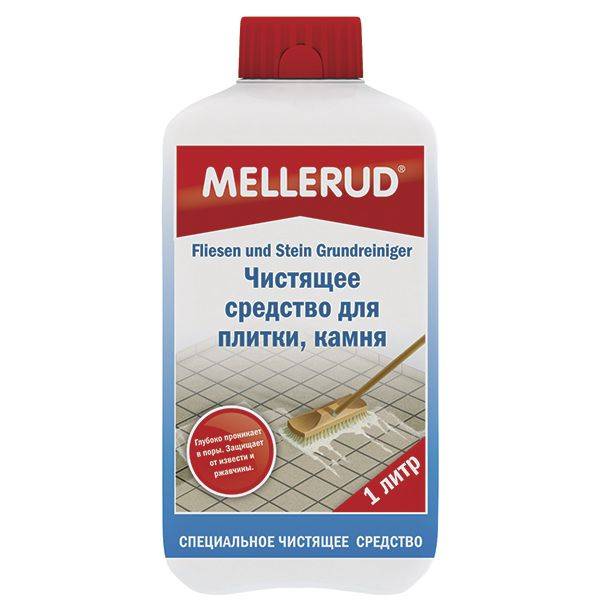
Basically, the products of the chemical industry are used when it is not possible to mechanically wipe off the grout from the tile with the corrugated side. To apply the composition, use a sponge or brush. The product is applied pointwise. With a large area of contamination, work is carried out in an accessible area, limited to the processing of two square meters. Gradually covering the rest of the zones. It is easier to work with small areas, if only because such a rubbed area of dirt at the very beginning will not have time to dry out while working with stains throughout the territory.After applying the product to the traces of the trowel mixture, you do not need to wait more than the time indicated by the manufacturer of the product. So how to wash tiles otherwise after renovation will be problematic.
Cleansing from fresh grout
Modern grouting mixture hardens within 24 hours, so it is easiest to wash it immediately after filling the tile joints. But first, after processing, it is required to check the seams for stability. Moisten them lightly and observe the reaction. If no changes have appeared, you can start washing away the contamination.
To do this, slightly wet a soft sponge in water, carefully wipe the joints of the tiles from dirt. When removing excess mortar from the facing tile, do not moisten the sponge abundantly - this can lead to distortion of the seams
If you missed the point, the cleaned seam dried out slightly and white marks appeared on the tiles, it is recommended to resort to the following cleaning measures:
- White spots are well washed with special felt trowels using ordinary dishwashing detergent or vinegar solution (100 grams of vinegar is added to 2 liters of water).
- The baking soda will help remove grout marks. On a slightly moistened surface of the tile, apply a little baking soda and begin the wiping process in a circular motion.
- In the fight against dirt on the relief tile, a felt grater soaked in vegetable oil will help.
Features of the removal of various types of grout
When choosing a means of dealing with grout stains, you need to know the type of mixture used in the work. An individual material is characterized by certain properties. The seizure takes place within 24 hours. Compositions with cement are used. The following methods are suitable for their removal:
- sandpaper rolled into a tube. Use without pressure. Removes defects and irregularities from the surface;
- if the marks did not have time to harden, wash them off with a damp sponge. To maintain the hermetic properties of the grout, do not wet the sponge too much;
- large, stubborn stains are removed with a baking soda paste. Apply the required amount to the cement, wipe it in a circular motion;
- remove whitish light bloom with a felt mitt or felt float. To achieve the result, a detergent is additionally used, a solution of water with 9% vinegar, dishwashing liquid, a concentrated solution with lemon acid powder;
- in the presence of heavy contamination on the embossed lining, carry out cleaning with a felt glove lubricated in vegetable oil.
To remove cement grout, it is undesirable to use abrasive substances, hard sponges on a metal basis, brushes, scrapers.
If the mixture has time to dry, a chemical cleaning method will come to the rescue.
Epoxy grout is a complex building material that adheres securely to the surface.
Product manufacturers claim that the composition reliably resists alkalis, acids and mechanical stress. For softening the grout remover is used: “Litokol”. It will dilute the stubborn stain, and then the substances created to dissolve the old epoxy paint are used.
Prepare a wire brush or other abrasive tool
It is important to protect tiles and joints from caustic mixtures with a double layer of masking tape.
Apply the anti-grout agent on dirt for 5 minutes. Try to gently rub it with a metal object. Try not to touch the masonry around. Remove the epoxy slowly, layer by layer.
After exposure, not all cladding will remain beautiful and smooth. The solvent can damage the color of the product, violate the integrity of the pattern, and spoil the gloss. After cleaning, after a while, whitish spots appear.
If the laying was carried out by a specialized company, do not remove the marks yourself. Submit your warranty claim. It will help you save on additional costs. The contractor is obliged to eliminate defects.
During repairs with laying tiles, ceramics or porcelain stoneware, it is necessary to monitor the workers, to prevent the occurrence of unpleasant consequences. The grout dries up in the next 20 minutes, but it takes 24 hours to completely dry. Use your time and quickly fix bugs. Stock up on special chemicals to remove grout marks or use folk remedies. They are safe for you and the facing material, and their effectiveness has been tested in practice. A quick response will help clear grout from tiles without losing their aesthetic appearance.
The article has been verified by the editorial staff


